Article and photos by Joe Mish
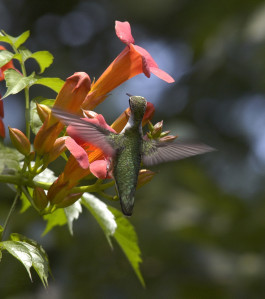
A hummingbird and orange trumpet flower engage in an evolutionary dance of equal partnership that has lasted for eons. The flower not only took advantage of an array of pollinators but also stole the heart of man who would seek to propagate flowers far beyond their natural range and ability to survive.
A name logically follows the existence of an idea, a person, place or a thing and forever provides an instant reference, complete with assigned identifiable characteristics. So before there was a month named May, a segment of time existed in nature where birth and bloom dominated the season.
The mythology from which the name of May arose was based on the same natural observations seen today. Stories of the stars and the gods became the reference points displayed on the night sky overhead projector to help explain observed phenomenon. The poetic phrase, “April showers bring May flowers” provides information sufficient enough for most people to understand the season. Instead of placing flowers at the altar of the goddess Maia we now send flowers to our mothers on a day designated to show her our appreciation, same story, different day.
Going back to the time before May, can you imagine discovering the first flower ever to bloom? In retrospect it would have meant that some plant had evolved to take advantage of a new method of pollination that relied on insects rather than wind. At the time of discovery, however, the moment had to be absolutely magical. Here was something so different in structure, color, scent and profusion that it instantly intensified a fledgling human emotion that speaks to the appreciation of beauty. The flower not only took advantage of insect pollinators but at that moment stole the heart of man who would later seek to propagate flowers far beyond their natural range and ability to survive.
Watching a rambunctious fox pup at a distance, I saw what appeared to be orange pollen on its solid black nose. As the pup was playing around the daylilies I imagined he stuck his nose inside a funnel shaped orange flower, designed for bees and hummingbirds, to come away with the telltale signs of brightly colored pollen grains. If he sniffed a few more flowers he actually became the “bee” and a willing, if not random, participant in asexual reproduction. The part that serendipity plays in nature and science can never be underestimated and its potential never unappreciated when unprecedented success results.
Fox pups are not the only pollinators unknowingly pressed into service by the ingenious evolutionary design of flowers. It is a laugh riot, for some reason, to see a dusting of yellow or orange pollen on the nose of a child or adult who sniffs a flower in pursuit of its scent. Eyes closed, as if about to plant a kiss, the human pollinator presses forward until nose touches stamen.
The entire event, so instinctive and innocently conducted, that the “bee” comes away unaware of its role in the evolutionary drama of species reproduction and survival. A kind friend will of course bring attention to the dusting of pollen left by such an intimate encounter and be trusted to address it discreetly.
Bees of all kind have ‘pollen baskets’ on their back legs which hold an accumulation of pollen grains that appear as large colorful round beads on opposite back legs. Watch one of those big furry yellow and black bees and you can easily see the lumps of colorful pollen that varies from flower to flower.
Paddling along the south branch, wild columbine can now be seen in select places on north and west facing red shale cliffs. These delicate plants grow from roots wedged between the layered red shale well above the surface of the water. The reddish pink tubular flowers with a common yellow center resemble a group of ice cream cones joined to form a common opening which leads to several individual tails. This structure encourages contact with the centrally located pollen that has to be brushed against in order to reach several sources of nectar located in each tail. This flower must have had a hummingbird sitting on the design team who decided not only the flowers structure but the time the flower was set to bloom. Hummers arriving in early spring from Mexico and Central America have a ready source of food to replenish the energy spent in their annual migration north.
Consider the greatest mayflower of all and the part it played in another notable migration. The “Mayflower”, was a ship that sailed to our shores bearing its human pollen to establish new life on the North American continent The ship, so named by unknown whimsy and intended as a supply barge, grew to evolve much as early flowers did into an effective delivery system directed by nothing more than chance. Like a flower it bloomed, spread its pollen and ‘died back’ soon after returning to England.
May apples, Virginia bluebells, trout lilies, trillium, jack-in-the pulpits and spring beauties are a small sample of local May flowers that represent the spectrum of a floral legacy whose genealogy traces back to the earliest flowers. Consider that flowers are living things that in some magical way recruited man to further their propagation in exchange for a glimpse of eternal beauty, dreams and imagination to expand the universe of human potential with unbounded creativity and expression.
Author Joe Mish has been running wild in New Jersey since childhood when he found ways to escape his mother’s watchful eyes. He continues to trek the swamps, rivers and thickets seeking to share, with the residents and visitors, all of the state’s natural beauty hidden within full view. To read more of his writing and view more of his gorgeous photographs visit Winter Bear Rising, his wordpress blog. Joe’s series “Nature on the Raritan, Hidden in Plain View” runs monthly as part of the LRWP “Voices of the Watershed” series. Writing and photos used with permission from the author.
Article and photos by Joe Sapia
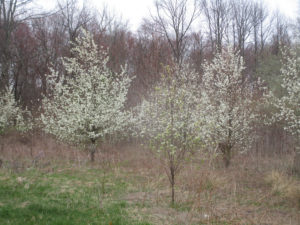
Callery pear trees taking over a field in Monroe, Middlesex County.
CALLERY PEAR TREES: Have you noticed the trees of blooming white flowers in abundance during your travels? Pretty? As we drive by them, yes. But take a closer look, these non-native, but once popular ornamentals, have large thorns, have week branches, and grow thickly. This thick growth prohibits beneficial native plant life from growing. Calleries cross-pollinate easily and produce small pears, which birds eat and, then, poop seeds through the countryside — resulting in more calleries. Enjoy the view and learn from them — that is probably the only good I can say about them.
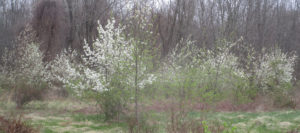
Callery pear trees along Route 130 in East Windsor, Mercer County.

A closeup of callery pears in Monroe, Middlesex County.
HEAVY RAIN…: The Jersey Midlands got clobbered with rain on the Sunday-Monday overnight and Monday, April 15-16 and 16. The National Weather Service reports the following rainfall totals in Midlands counties, although these reported records may not be complete records:
Burlington: 1.94 inches at Joint Base McGuire Dix Lakehurst to 2.50 at Southampton.
Hunterdon: 2.34 at Lebanon to 2.51 at Readington.
Mercer: 2.33 at Trenton-Mercer Airport.
Middlesex: No reading available.
Monmouth: 3.17 at Wayside.
Ocean: No reading available.
Somerset: 2.20 at Middlebush to 2.83 in the Hillsborough area.
Bucks County, Pennsylvania: 2.85 at Doylestown Airport.
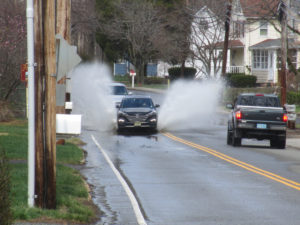
Flooding at Saw Mill Brook in Helmetta, Middlesex County.
…AND WIND: On Monday, April 16, besides getting hit hard by rain, the Jersey Midlands got pretty good winds. According to the nj.com website, strong winds were recorded at:
Monmouth County: 47 miles per hour at Sea Girt.
Ocean County: 51 miles per hour at Tuckerton and Joint Base McGuire Dix Lakehurst.
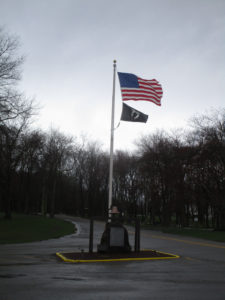
The wind whips these flags at Thompson Park on the boundary of Jamesburg and Monroe in Middlesex County on Monday, April 16.

“Jamesburg Lake” (properly Lake Manalapan) at Thompson Park on the boundary of Jamesburg and Monroe, Middlesex County, is wind-driven Monday, April 16.
GROUNDHOG IN THE WATER: I do not think of ground hogs, “Marmota monax,” and water going together. But I spooked one near Manalapan Brook. A hole dug under a tree was flooded, but the ground hog fled me, into the flooded hole. At 61-years-old, all my life in these Pine Barrens around Helmetta, I still learn.
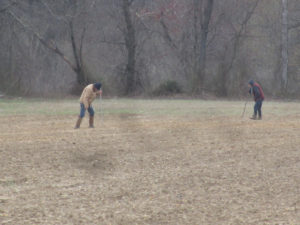
Two women searching for American Indian artifacts in a farm field on the Cranbury-Plainsboro boundary, Middlesex County.
SNOW: I received a report of snow falling Tuesday, April 17, in the Cranbury-Plainsboro area of Middlesex County. Since the winter of 1995-1996, this would be the latest snowfall I am aware of in South Middlesex County. Previously, I knew of April 16 in 2007. This season, I recorded 42.5 inches at my home in Monroe, Middlesex County; Normal, based at New Brunswick about 7.5 miles away, would be about 26 inches. Basically, half of this season’s snow did not fall until March 2 or later.

A double-crested cormorant, “Phalacrocorax auritus,” on “Jamesburg Lake” (properly Lake Manalapan) on the boundary of Jamesburg and Monroe, Middlesex County.
SHAD RUN: I ran into Don Kamienski, a field editor for The Fisherman magazine, at this year’s Outdoors Writer’s Workshop, sponsored by the state Division of Fish and Wildlife. Don, who lives along the Delaware River in Burlington County, told me the shad were already running up the river. The annual Shad Fest in Lambertville, Hunterdon County, is Saturday and Sunday, April 28 and 29. More information is available at http://www.shadfest.com.

Shad Fest, 2011 — Various festival posters and one of the artists involved.
BEWARE THE LANDSCAPER: As it warms and we get into our yards and gardens, beware of hiring landscapers or gardeners. Have some reasonable faith in them. For example, I see way too much “volcano” mulching, rather than the proper “doughnut” mulching. The buildup of volcano mulching invites fungus into the mulch and disease into the tree. (Why mulch at all?) Also, I see white rock circles around trees; It just heats up the tree. Another recent sighting was a lawn treatment of topsoil on top of old lawn, then a seeding on top of the topsoil; One, it is the wrong time of year to properly plant a lawn and, two, why not remove the old lawn and aerate? Also, topsoil is not regulated, so try to make sure you know what you are getting.

Houseplants in the living room window in my house in Monroe, Middlesex County. A cardinal, “Cardinalis cardinalis,” perched in a tree outside the window.
GOLDFINCHES, SKUNK CABBAGE, ETC.: Another sign of spring is the yellowing of male eastern goldfinches, “Spinus tristis.” “Spring males are brilliant yellow and shiny black with a bit of white,” according to Cornell University’s All About Birds website. “Females and all winter birds are more dull, but identifiable by their conical bill; pointed, notched tail; wingbars; and lack of streaking. …The brightening yellow of male goldfinches each spring is one welcome mark of approaching warm months.” This species is the New Jersey state bird. And skunk cabbage, “Symplocarpus foetidus,” is greening up in wetlands.
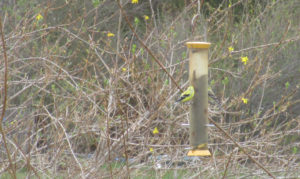
Two eastern goldfinches, the colorful male on the left and the duller female on the right, on my backyard finch feeder in Monroe, Middlesex County.
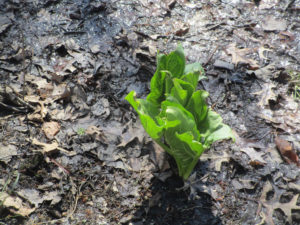
Skunk cabbage in the Millstone River floodplain on the boundary of Cranbury and Plainsboro, Middlesex County.
TONY’S MARKET: For the first time this season, I visited one of my favorite places, Tony’s Farm and Garden Center in Robbinsville, Mercer County. At Tony’s, I usually buy house plants — On this trip, I picked up a wandering Jew and a fuschia — house plant supplies, tomato plants, seeds, and perhaps other odds and ends. I have been a Tony’s customer for 25 or so years. Also, a trip to Tony’s includes me walking through the greenhouses, shooting photographs. Many thanks to the Ciaccio family. I normally deal with Tony, a third generation of the family. (My other two regular nursery stops are Krygier’s in South Brunswick, Middlesex County, and Ferris Farms Garden Center in East Brunswick, Middlesex County. All three are courteous and very helpful.)

Blooming flowers at Tony’s Farm and Garden Center in Robbinsville, Mercer County.
DRIVE-BY NATURALIST: I was driving to a Monmouth County section of the state’s Assunpink Wildlife Managment Area to attend the annual Outdoor Writer’s Workshop, sponsored by the state Division of Fish and Wildlife. While driving on Route 539 in East Windsor, Mercer County, a male northern harrier, “Circus hudsonius,” flew only a few feet off the ground and only a few feet in front of my Jeep, crossing my path from left to right. This sleek hawk is one of my favorite birds of prey. To see one close-up, if only only a glimpse, is a sight. Because it was a quick-happening event, I was unable to photograph the harrier.
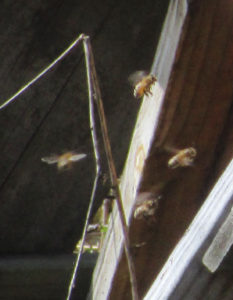
Pollinators, honeybees on the Kiesler farm along the boundary of Cranbury and Plainsboro, Middlesex County.
OUTDOOR WRITER’S WORKSHOP: As a journalist, I have been attending the state Outdoor Writer’s Workshop, sponsored by the New Jersey Division of Fish and Wildlife, on and off for about 30 years. I am a little off my turf because it is basically attended by hunting and fishing writers, rather than naturalists such as me, but the talks are informative. This year, I was able to catch the welcome by Larry Herrighty, director of Fish and Wildlife; Paulette Nelson, assistant director, on “Recovering America’s Wildlife Act,”; Ross Shramko’s “Results of the Strocked Trout Movement Study in Flat Brook”; and Sharon Petzinger’s “Songbird Response to Forest Management in Northwestern New Jersey.” Many thanks to Al Ivany, chief of Fish and Wildlife’s Office of Wildlife Education and Information, for inviting me every year. The lunch, catered by Mastoris Diner-Restaurant, one of my old hangouts in Bordentown Township, Burlington County, is a treat. (Disclosure: Beginning a few months ago, I became a Fish and Wildlife volunteer, primarily keeping tabs on the Upper Millstone River bald eagle, “Haliaeetus leucocephalus,” nest on the boundary of Mercer and Middlesex counties.)
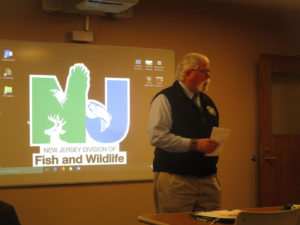
Larry Herrighty, director of the state Division of Fish and Wildlife, welcome attendees to the 2018 Outdoor Writer’s Workshop.
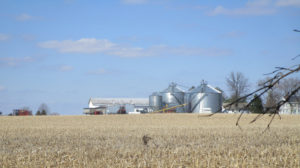
A vanishing scene of farmland, here on the Cranbury-Plainsboro boundary of Middlesex County.
VOICES FROM AFIELD, FRANK ULATOWSKI: Frank Ulatowski, an outdoorsman-friend from Manalapan-Englishtown, Monmouth County, is looking to get rid of circa late 1930s-early 1940s Allis Chalmers tractor. In its deteriorated condition, it probably would be best used for parts. Frank is reachable at Frank’s Auto Repairs in Manalapan-Englishtown, telephone 732-446-7616.
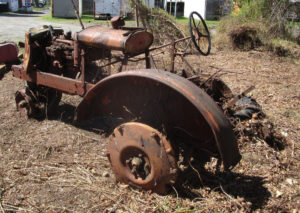
The circa late 1930s-early 19402 Allis Chalmers tractor in Manalapan-Englishtown, Monmouth County.
SKY PHOTOS: This week’s sky photos are from the areas of Helmetta, Monroe, Cranbury, Plainsboro, South Brunswick, and East Brunswick in Middlesex County; Upper Freehold in Monmouth County; and East Windsor and West Windsor in Mercer County.
A night view from my backyard in Monroe, Middlesex County.
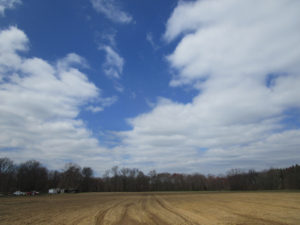
The Kiesler farm on the boundary of Cranbury and Plainsboro in Middlesex County and East Windsor, Mercer County.
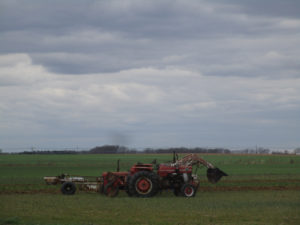
The Kiesler farm looking toward the Cranbury, Middlesex County, side.
The Kiesler farm on the boundary of Cranbury and Plainsboro, Middlesex County, looking toward Grover’s Mill, Mercer County.

Along the Millstone River on the boundary of Plainsboro and Cranbury on the Middlesex County side and East Windsor and West Windsor on the Mercer County side.

From my backyard in Monroe, Middlesex County.

Sky over the cuesta geologic formation in Upper Freehold, Monmouth County.
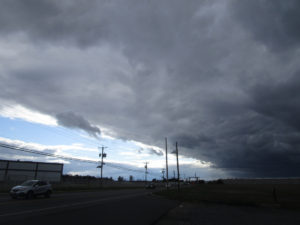
South Brunswick Middlesex County.
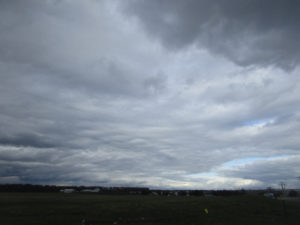
South Brunswick, Middlesex County.
Over a swamp hardwood forest on the boundary of Helmetta and East Brunswick, Middlesex County, in the Pine Barrens around Helmetta.
SUNRISE AND SUNSET: For the week of Sunday, April 22, to Saturday, April 28, the sun will rise about 6:10 to 6 a.m. and set about 7:45 to 7:50 p.m. For the week of Sunday, April 29, to Saturday, May 5, the sun will rise about 6 to 5:50 a.m. and set about 7:50 to 7:55 p.m.
NIGHT SKY: The next full moon is April 29, the Sprouting Grass Full Moon.

The crescent moon and the planet Venus, from my backyard in Monroe, Middlesex County.
ATLANTIC OCEAN TEMPERATURE: The Atlantic Ocean temperature off New Jersey was about 51 degrees.

A squirrel, “Sciurus carolinesis,” at my backyard bird feeder in Monroe, Middlesex County.
WEATHER: The National Weather Service office serving the Jersey Midlands is at https://www.weather.gov/phi/.
UPCOMING:
April 28, Saturday, 10 a.m. to 4 p.m., Middlesex County, New Brunswick: Rutgers University Ag Field Day, Cook Campus, Route 1 and Ryders Lane. More information is available at website http://agfieldday.rutgers.edu.
April 28 and 29, Saturday and Sunday, Hunterdon County, Lambertville: Shad Fest event of environmentalism, entertainment, food, crafts. More information is available at http://www.shadfest.com.

Inside the greenhouse at Tony’s Farm and Garden Center in Robbinsville, Mercer County.
REDUCING MY CARBON FOOTPRINT: As I awoke one morning, I listened to a radio broadcast about reducing one’s carbon footprint. I thought, Where am I failing to be an environmentalist? My answer is I drive too much, probably in the 20,000 miles-per-year range. I should work on this. Well, a few hours later, my Jeep was in the shop again for an ongoing clutch-dashboard area problem. Several weeks ago, I had no Jeep for 10 days — and survived quite well, walking and bicycling. So, here we go again. Fortunately, this is my slow time of year for work and with the little work I have this time of year, I can survive without a motor vehicle — I hope. Which leads me to a related story…
…BICYCLING: Without my Jeep, I bicycled from my Monroe house, through Helmetta, to Spotswood, all in Middlesex County, for breakfast. On my way back, I stopped at Timmy Mechkowski’s farmette in Helmetta. Timmy has a woodcutting operation there and I needed one log for the woodstove Timmy gave me. I grabbed the wood, tied it to rack of my second-hand, but lovingly trusty, circa 1980 Schwinn Collegiate coaster bicycle. Chris, the pizza delivery woman, saw my parked bicycle with the firewood and thought, Who would do something like this? Then, she saw it was my bike and she added, Now, it makes sense. I am like the “Log Lady” on the old Twin Peaks television show…

My coaster bicycle hauling firewood.
BURNING THE LOG: After watching on television my Toronto Maple Leafs beat the Boston Bruins is a National Hockey League playoff game, I went to my woodstove in my garden and threw in the log. I figured I would hang out under the stars on a cool night with a warm woodstove. Well, I gave up that idea when I realized I was smoking out the neighborhood. I guess the log was too wet. So, I watered down the fire and called it a night.

The woodstove in my garden with the log on top.
Joe Sapia, 61, is a lifelong resident of Monroe — in South Middlesex County, where his maternal family settled more than 100 years ago. He is a Pine Barrens naturalist and an organic gardener of vegetables and fruit, along with zinnias and roses. He loves the Delaware River north of Trenton and Piedmont, too.
He draws inspiration on the Pine Barrens around Helmetta from his mother, Sophie Onda Sapia, who lived her whole life in these Pines, and his Polish-immigrant grandmother, Annie Poznanski Onda.
He gardens the same backyard plot as did his Grandma Annie and Italian-American father, Joe Sr. Both are inspirations for his food gardening. Ma inspires his rose gardening.
Joe is a semi-retired print journalist of almost 40 years. His work also is at @JosephSapia on Twitter.com, along with The Jersey Midlands page on Facebook.com on the Jersey Midlands page.
Copyright 2018 by Joseph Sapia
Article and photos by Joe Sapia
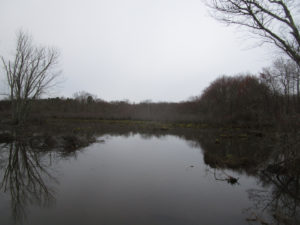
Matchaponix Brook near Englishtown Market in Manalapan, Monmouth County. This section of the brook is both diamond and rough — a beautiful natural world fighting the nonpoint-source pollution along Route 527. Brook in the foreground, swamp hardwood forest in the near background, and in the left of the far background, pitch pine trees of the Spotswood Outlier, disconnected from the main section of the Pine Barrens to the south.
MATCHAPONIX BROOK AT ROUTE 527: I am 61-years-old and have been crossing Matchaponix Brook at Englishtown Market in Manalapan, Monmouth County, since as far back as I can remember. Yet I never gave much thought to the natural world here — until Englishtown outdoorsman Gary Forman relayed information to me through our mutual friend, outdoorsman Frank Ulatowski. This is the beginning of Matchaponix Brook, formed by the joining of Weamaconk Creek and McGellairds Brook. When I stopped by this week, I was amazed. Step only a few feet away from busy Route 527 and one is in a beautiful natural world of brook; swamp hardwood forest; a lodge of beaver, “Castor canadensis”; mallards, “Anas platyrhynchos”; great blue heron, “Ardea herodias”; and the telltale pitch pine, “Pinus rigida,” of the Pine Barrens because this is part of the Pines’s disconnected Spotswood Outlier. Probably plenty more that I did not notice. Unfortunately, I did notice the nonpoint-source pollution — garbage gathering in Matchaponix Brook. Take away this garbage and the busyness of Route 527 and I was in a wonderful natural world. Again, we should keep our eyes open because the natural world is around us, even if we taint it.
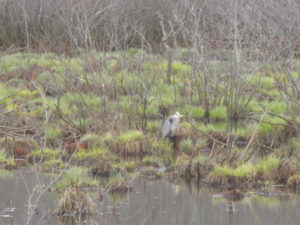
A great blue heron on Matchaponix Brook in Manalapan, Monmouth County.
AS BEAUTIFUL AS MATCHAPONIX BROOK IS AT ROUTE 527…: Nonpoint-source pollution — basically debris, such as litter or materials blown offsite, with no specific origin — is a major problem in our world. Simply look at litter along a road or, in this case, gathered in Matchaponix Brook at Route 527 in Manalapan, Monmouth County. Generally, the source of this garbage appears to be debris that drains into the brook and Route 527 littering.
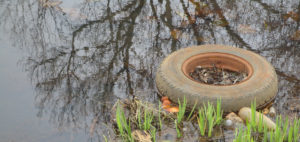
Garbage in Matchaponix Brook at Route 527 in Manalapan, Monmouth County.
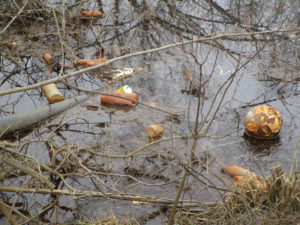
Garbage in Matchaponix Brook at Route 527 in Manalapan, Monmouth County.
MATCHAPONIX BROOK: In the Englishtown area of Monmouth County, Weamaconk Creek and McGellairds Brook join to form Matchaponix Brook. The brook then flows for about 5 miles, as the crow flies, to the north and merges with Manalapan Brook to form the South River on the boundary of Monroe, Spotswood, and Old Bridge in Middlesex County. “Matchaponix” is a Lenni Lenape Indian word for “land of bad bread,” or land where corn does not grow well. I speculate this name comes from the Matchaponix Brook area being in the Spotswood Outlier of the Pine Barrens, or an area of sandy soil not conducive to growing corn or other conventional crops. (Conversely, “Manalapan” means “land of good bread.” Manalapan Brook begins and runs for miles in a non-Pine Barrens area, or an area of darker, gravelly soil that is good for growing corn.)
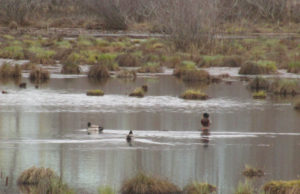
Mallards on Matchaponix Brook in Manalapan, Monmouth County.
SPRING SPRINGING: People are fishing. Listen in the early morning and you will likely hear birds singing. Look at a woods and you likely will see the red buds of trees. Flowers are blooming in gardens. Nature is coming alive with spring.
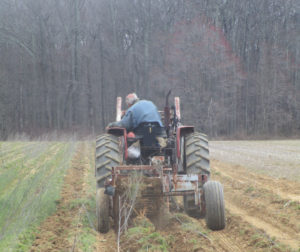
Warren Kiesler churns up horseradish plants on his farm in Cranbury, Middlesex County. To the right of the tractor in the background, notice the tree budding.

An angler at “Jamesburg Lake’ (properly “Lake Manalapan”) on the boundary of Jamesburg and Monroe, Middlesex County.
ROBINS IN THE YARD: With the coming of spring-like weather, it means the likelihood of seeing robins, “Turdus migratorius,” in our yards. I have noticed more of them around my yard in Monroe, Middlesex County. This week, I watched a robin pull a worm from my garden. “Although robins are considered harbingers of spring, many American Robins spend the whole winter in their breeding range,” according to Cornell University’s All About Birds website. “But because they spend more time roosting in trees and less time in your yard, you’re much less likely to see them.” As the weather warms and nature comes alive, they move to yards because of the availability of such things as worms. “American Robins are common sights on lawns across North America, where you often see them tugging earthworms out of the ground,” according to the Cornell website.
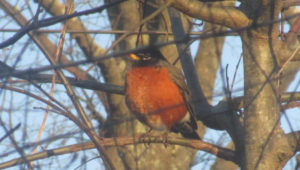
A robin in the shrubs of my front yard in Monroe, Middlesex County.
HORSERADISH FARMING: With the collapse of newspapers and, in turn, the collapse of my approximately 35 years as a reporter – basically from 21-years-old when I got my journalism degree to 55-years-old – I am always looking for work. Over those 5-plus years, I have been a part-time staff writer on a weekly paper, freelance writer, writing teacher, security guard. Security guarding, which I did during my college years and resumed these years later, now takes me from a Central Jersey professional park to the perimeter around foreign cargo ships where Maryland’s Patapsco River meets Chesapeake Bay. As I like to say, I have the best syntax at the Baltimore docks and am the only employee of Rutgers University’s Plangere Writing Center that wears a hard hat on his other job. This week, at 61-years-old, add laborer at the Kiesler horseradish farm to my resume.

Harvested horseradish on Kiesler farm in Cranbury, Middlesex County.
SNOWBIRDS GOING, GOING…: When will “snowbirds” — juncos, “Junco hyemalis” — be gone for the season? Based on field notes I have kept over the years, they should be leaving Monroe, Middlesex County, any day now to about April 25 or so. They will head to high ground, as close as North Jersey or Pennsylvania or as far as Canada. Then, I will see them again around the yard about mid-October to early November.
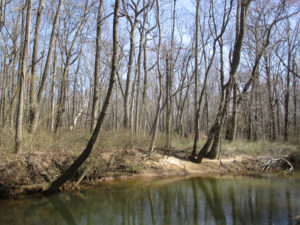
Manalapan Brook in the section of Monroe between Helmetta and Jamesburg, Middlesex County.
IN MY GARDEN: I finished the planting of the early spring crop — Kaleidoscope Blend Carrots, Touchon Heirloom Carrots, Bloomsdale Long-Standing Heirloom Spinach, Early Wonder Heirloom Beets, and Salad Bowl Lettuce, all Burpee products.
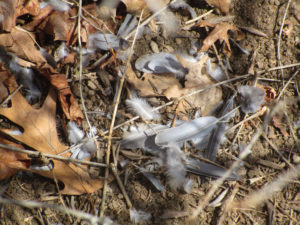
I found this in my garden. Something got this bird, the remains possible those of a mockingbird, “Mimus polyglottos.”
YARDWORK: I tackled the first yardwork of the season, working the front yard. I trimmed trees and prepared soil to plant zinnia and warm-season vegetables. The latter is a continuation of my plan to make my one-quarter-acre yard as productive as possible. With that idea, I am trying to minimize a generally unproductive lawn as much as possible.
PRINCETON ENVIRONMENTAL FILM FESTIVAL: I attended the annual Princeton Envirionmental Film Festival, seeing part of the “Evolution of Organic” movie and the entire “Seed to Seed” movie, both about organic farming. I also got to see the talk of Dr. Joe Heckman — organic farmer, a member of the board of directors of Northeast Organic Farming Association of New Jersey, and Rutgers University soil scientist — after the showing of the “Evolution of Organic” and got to socialize with Joe. (Joe and his wife, Joyce Goletz Heckman, own Neshanic Pastures farm in East Amwell, Hunterdon County. Joyce and I are childhood friends from Monroe, Middlesex County.)

Awaiting a movie at the Princeton Environmental Film Festival.

Dr. Joe Heckman, who spoke on organic farming at the Princeton Environmental Film Festival. Joe is an organic farmer, a member of the board of directors of Northeast Organic Farming Association of New Jersey, and Rutgers University soil scientist.
UPPER MILLSTONE RIVER EAGLES: We are pretty sure the nest of bald eagles, “Haliaeetus leucocephalus,” on the Upper Millstone River on the boundary of Mercer and Middlesex counties, has one eaglet in it. The baby should fledge in early to mid-May or the early end to early June on the far end. Then, the family should stay together in the area. After fledging, the young eagle or eagles should stay in the area until about early September to early December. (The bald eagle remains in New Jersey an “endangered” breeder – that is, in immediate jeopardy as a breeder – and “threatened” in general – that is, in danger of becoming “endangered” if conditions deteriorate.)
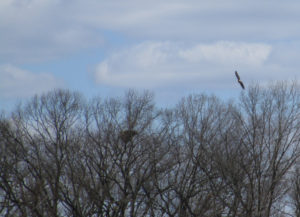
An adult bald eagle landing on the Upper Millstone River nest.
GARDEN WRITING: A great pleasure of mine is to be back at the Princeton Adult School this semester, again teaching non-fiction writing. In the past, I have taught the essay and the vignette. This semester, the course is called “Garden Writing,” but is really about gardens, the outdoors, or nature. Because of its title, the course has drawn a class of passionate gardeners. This passion inspires wonderful stories. Just this week, I have read papers about dandelions, beginning spring plantings indoors, tomatoes and their guests of the hornworm and Braconid wasp. The dozen or so in this class make it a joy to teach.
THINGS THAT DO NOT BELONG: Just because something is outdoorsy does not mean it belongs everywhere in the outdoors world. On the Millstone River on the boundary of East Windsor, Mercer County, and Cranbury, Middlesex County, I noticed ornamental daffodils growing in the river floodplain. I suspect these were purposely planted or they grew from waste soil. They looked pretty along the river, but they are a non-natives that do not belong there.
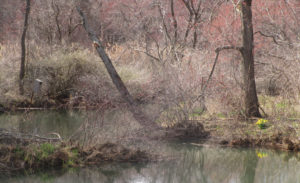
These daffodils look pretty blooming along the Millstone River on the boundary of Cranbury, Middlesex County, and East Windsor, Mercer County. But they are ornamentals that do not belong in the wild.
SKY PHOTOS: This week’s sky photos are from Monroe, Cranbury and Plainsboro, all in Middlesex County.
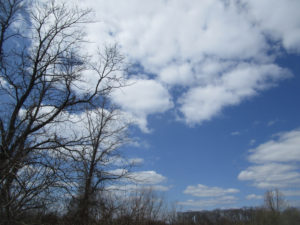
Sky above farmland in Monroe, Middlesex County.
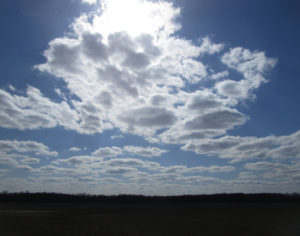
Sky above farmland in Cranbury, Middlesex County.

Above my backyard in Monroe, Middlesex County.
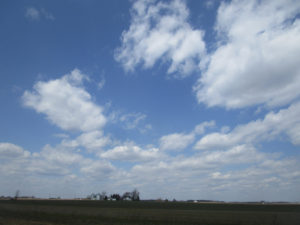
Above farmland on the Cranbury-Plainsboro boundary, Middlesex County.
SUNRISE AND SUNSET: For the week of Sunday, April 15, to Saturday, April 21, the sun will rise about 6:20 to 6:10 a.m. and set about 7:35 to 7:45 p.m.
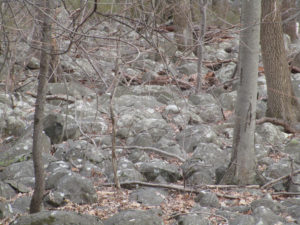
A Piedmont boulder field on the Princeton Ridge in Princeton, Mercer County. Notice the lichen growing on the rocks. Lichen is a sign of fresh air.
MOON: The next full moon is April 29, the Sprouting Grass Full Moon.
ATLANTIC OCEAN TEMPERATURE: The Atlantic Ocean temperature off New Jersey was about 46 to 52 degrees.
WEATHER: The National Weather Service office serving the Jersey Midlands is at https://www.weather.gov/phi/.
UPCOMING:
April 21, Saturday, 11 a.m. to 2 p.m., Burlington County, Southampton: The Pinelands Preservation Alliance’s 13th Annual Native Plant Sale, Alliance headquarters, 17 Pemberton Road (Route 616). More information is available from the alliance, telephone 609-859-8860 or website http://www.pinelandsalliance.org.
April 28, Saturday, 10 a.m. to 4 p.m., Middlesex County, New Brunswick: Rutgers University Ag Field Day, Cook Campus, Route 1 and Ryders Lane. More information is available at website http://agfieldday.rutgers.edu.
April 28 and 29, Saturday and Sunday, Hunterdon County, Lambertville: Shad Fest event of environmentalism, entertainment, food, crafts. More information is available at http://www.shadfest.com.
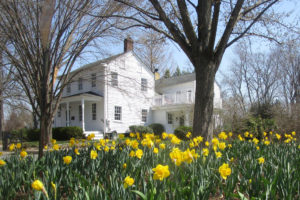
Daffodils in bloom in Cranbury, Middlesex County.
Joe Sapia, 61, is a lifelong resident of Monroe — in South Middlesex County, where his maternal family settled more than 100 years ago. He is a Pine Barrens naturalist and an organic gardener of vegetables and fruit, along with zinnias and roses. He loves the Delaware River north of Trenton and Piedmont, too.
He draws inspiration on the Pine Barrens around Helmetta from his mother, Sophie Onda Sapia, who lived her whole life in these Pines, and his Polish-immigrant grandmother, Annie Poznanski Onda.
He gardens the same backyard plot as did his Grandma Annie and Italian-American father, Joe Sr. Both are inspirations for his food gardening. Ma inspires his rose gardening.
Joe is a semi-retired print journalist of almost 40 years. His work also is at @JosephSapia on Twitter.com, along with The Jersey Midlands page on Facebook.com on the Jersey Midlands page.
Copyright 2018 by Joseph Sapia
Article and photos by Joe Mish
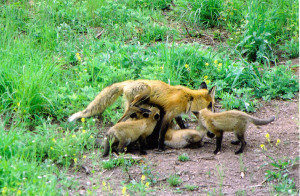
Eager and hungry fox pups survived the mercurial spring floods to feed voraciously on mom in the bright sunlight of a late April morning.
April is the quintessential month of spring, the first month to start with a vowel after a bleak winter of hard consonant constructed months. The name April is probably derived from the Latin infinitive, aperere, ‘to open’, but that consideration is at the risk of offending the claims of the goddess of love, Aphrodite, and Apollo the son of Zeus, their namesake month.
I see April as a grand series of ever changing dance steps performed in tune to the great celestial choreography of the planets and stars. One planetary misstep and the world comes crashing down. It is, however, a play without flaw that brings the predictability of the seasons and the impish April to improvise her set of daily surprises that precede the full bloom of May.
April is a charming minx with dancing green eyes whose mercurial ways give false hope to early gardeners as she whirls in the white robes of a sudden snow squall. Days of bright sunshine are mixed with bone chilling moist air, frosts and gentle rain or hailstorms of biblical proportion. These are the veils April sheds as she improvises dance steps to tease and mislead, all the while faithfully delivering the solemn promise of May.
Edwin Way Teale, a noted author and naturalist claims that, “spring approaches from the south at fifteen miles a day”. If you were to drive from New Jersey to Maine in mid April, you could actually see spring approach.
Travelling north, you go back in time to see spring begin.
As you drive through New Jersey, forsythia planted along road medians would be in full yellow bloom as tree buds give birth to pale green leaves.
The crowns of naturalized red maple dominated hardwoods would have shed their maroon veil to now wear a haze of light green unfurling leaves that will continue to darken as they mature
Oak dominated hillsides and lowlands scattered with black gum, hard maple, beech, ash and sycamore appear as colorful as autumn with interlacing crowns covered in non reflective red, yellow, pink and salmon hued emerging leaves.
The color and blooms slowly fade as you travel north. The further you travel in one day, the more the landscape appears as if drawn on individual sheets of paper flicked by hand to appear as if moving. The individual frames of the ‘movie’ become alive and reveal the living, leading edge of the manifestations of spring.
The return journey south allows you to enjoy the second coming of spring and the insight that comes with a second chance.
Along the South Branch, a Great Horned Owl has been nurturing a clutch of eggs that will produce at least one full sized, flightless owlet to stand constantly alert for parental food deliveries in mid April.
During two trips down the South Branch in February and March, a female red fox ran along the river bank to expose herself as if to draw me away from her riverside den. She would run along the bare vertical bank then walk out onto a gravel bar, sit down and watch me approach. When I got too close she would run off and wait further downstream. At one point she ran across a sand bar that was flanked by a pair of mallards standing on the bare ground and a great blue heron posed in foot deep water. All three birds stood perfectly still as the fox ran between them. Neither the ducks nor the heron made any move to escape as if they knew the fox was not a threat that day.
I can only hope the fox waited until April to have her pups in light of the flood that came in late March. Perhaps April will reveal a gentle rain that favors the survival of not only the fox pups, but the bank swallows, flycatchers, muskrat and turkeys that might have dens or nests close to the riverbank and flood plain.
It is amazing how migration, breeding, births and nurturing coincide with seasonal events as if truly participating in a dance whose every step is critical to survival.
We have evolved physiologically to fit into a small, ‘temporary’ niche circling in an eddy on the river of change. If the changes take place faster than we can evolve, we go away.
Despite the vagaries of April’s whim, she shows the world an emergence of life that has learned her fickle ways and dances in step to lovingly embrace such a wild partner.
Author Joe Mish has been running wild in New Jersey since childhood when he found ways to escape his mother’s watchful eyes. He continues to trek the swamps, rivers and thickets seeking to share, with the residents and visitors, all of the state’s natural beauty hidden within full view. To read more of his writing and view more of his gorgeous photographs visit Winter Bear Rising, his wordpress blog. Joe’s series “Nature on the Raritan, Hidden in Plain View” runs monthly as part of the LRWP “Voices of the Watershed” series. Writing and photos used with permission from the author.
Article and photos by Joe Sapia
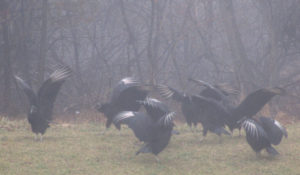
The dance of the black vultures, “Coragyps atratus,” in a professional park in Plainsboro, Middlesex County. These vultures were near a deer carcass, so they could have been spreading their wings to rid them of any bacteria picked up while feeding on the dead body. Or it could be a simple drying of the wings, although the day was foggy.
BLACK VULTURES, UP FROM THE SOUTH: As I have mentioned in the past, I do not recall seeing a black vulture, “Coragyps atratus,” until about the middle 1990s. They are more of a southeastern United States species. Now, I see them frequently in the Jersey Midlands. The species “has expanded range northward in the northeast, but has declined in parts of southeast,” according to the National Audubon Society’s website. “Loss of good nest sites in large tree hollows may be one cause.”
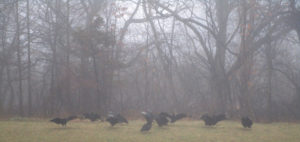
Black vultures on a foggy day in a professional park in Plainsboro, Middlesex County.
BLACK VULTURES ON A CARCASS: In a professional park in Plainsboro, Middlesex County, lie a well-picked-over carcass of a deer, “Odocoileus virginianus,” presumably the victim of motor vehicle accident. It was not picked-over enough for black vultures, “Coragyps atratus,” to be uninterested. There were about 10 on or near the carcass. Black vultures feed on “mostly carrion,” according to the National Audubon Society website. The species “feeds on carcasses of dead animals of all sizes.” And from Cornell University’s All About Birds website, “Turkey vultures (“Cathartes aura”) have an excellent sense of smell, but black vultures aren’t nearly as accomplished sniffers. To find food they soar high in the sky and keep an eye on the lower-soaring turkey vultures. When a turkey vulture’s nose detects the delicious aroma of decaying flesh and descends on a carcass, the black vulture follows close behind. One on one at a carcass, black vultures lose out to the slightly larger turkey vulture. But flocks of black vultures can quickly take over a carcass and drive the more solitary turkey vultures away.” I saw no turkey vultures at the carcass.
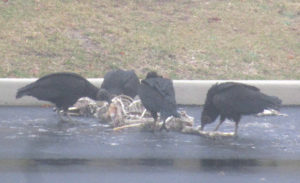
Black vultures on a deer carcass in a professional park in Plainsboro, Middlesex County.
DEER DAMAGE: Damage from browsing deer, “”Odocoileus virginianus,” is quite apparent, if you know what to look for. Look where ornamentals are planted. If you see arbor vitae with a thin bottom and a tipped top, kind of like an arrow pointed upward, you are probably looking at deer damage — the bottom being what is easily reachable to the deer, the top being harder to reach or out of reach.

Deer damage on these evergreen ornamental trees on a foggy day in a professional park in Plainsboro, Middlesex County.
MULCHING TREES: The concept of mulching a tree is to retain water to the root area while the tree is getting established. Well, if you are going to mulch, please do it correctly. That is, think “doughnut,” not “volcano.” Regarding the proper way, build a “doughnut” outside of the trunk — the hole around the trunk, the ring not touching any trunk or roots. Run the rim out to the end of the root ball or to the end of the tree canopy. The mulch should be only 2- to 3-inches deep. (Regarding a volcano, its massive depth could introduce and hold contaminants, while its touching the tree could introduce contaminants to the tree itself. Also, why mulch an established tree? Aesthetics — and property owners love aesthetics. Sorry, but I view that as image over substance.
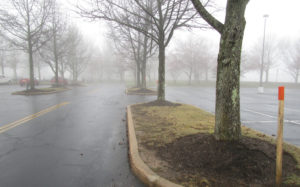
Volcanoes, the wrong way to mulch a tree. Here in a professional park in Plainsboro, Middlesex County.
THE DRIVE-BY NATURALIST: A doctor’s appointment in this Plainsboro, Middlesex County, professional park got me a lot of material for this writing. So, as I keep reminding, be prepared. There is a lot of nature around us. As much as I preach about keeping an eye out for things happening in the natural world, I missed a rare photograph — a flying adult bald eagle, “Haliaeetus leucocephalus,” and an Air Force jet circling Joint Base McGuire-Dix-Lakehurst. Per my duties as a state Division of Fish and Wildlife volunteer, I was observing the Upper Millstone River eagle nest on the boundary of Mercer and Middlesex counties, including shooting photographs. An adult eagle left the nest and was circling the area, flying farther and farther south from the nest — in the direction of the military base. At the same time, the Air Force cargo plane was circling the base. There they were, two flying symbols of American freedom in one frame. Well, nowadays, I have only a point-and-shoot camera. Instead of focusing on the eagle and plane in the background, the camera focused on the tree branches in the foreground. So, the eagle and plane are a blur. My fault. Despite the capture-the-moment shot, I should have made sure the camera was properly focused.
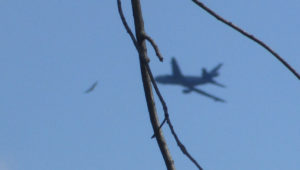
A missed photograph opportunity of two flying symbols of American freedom — a bald eagle circling in front of the Upper Millstone River nest and a plane circling Joint Base McGuire-Dix-Lakehurst.
UPPER MILLSTONE RIVER EAGLES: The bald eagles, “Haliaeetus leucocephalus,” on the Upper Millstone River nest on the boundary of Mercer and Middlesex counties seem to have been attending to their young for weeks. So, the baby or babies — it is unknown if there is one baby or more in the nest — should fledge in early to mid-May on the early end to early June on the far end. Then, the family should stay together in the area. After fledging, the young eagle or eagles should stay in the area until about early September to early December. (The bald eagle remains in New Jersey an “endangered” breeder – that is, in immediate jeopardy as a breeder – and “threatened” in general – that is, in danger of becoming “endangered” if conditions deteriorate.)
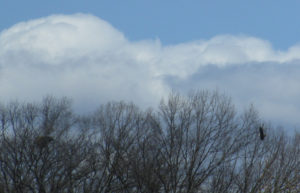
An adult bald eagle flies into the Upper Millstone River nest, left, on the boundary of Mercer and Middlesex counties.
SNOWFALL THIS WEEK: This week at my house in Monroe, Middlesex County, snow fell Monday, April 2 — and estimated 2 inches. Also on April 2, I noticed the first forsythia blooming this season in Mercer County (Hightstown and East Windsor) and Middlesex County (Cranbury and South Brunswick).
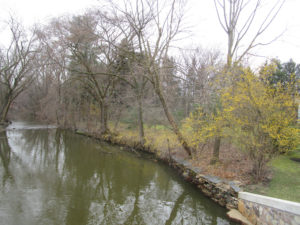
Forsythia blooming along Cranbury Brook in Cranbury, Middlesex County.
SNOWFALL TO DATE: With the Monday, April 2, snowfall of about 2 inches at my house in Monroe, Middlesex County, the seasonal snowfall total is 42.5 inches. What a late snow period — prior to March 2, 21.5 inches fell; from March 2 to April 2, 21 inches fell. (The seasonal average at New Brunswick, about 7.5 miles away, is about 26 inches.)

A tranquil Brainerd Lake (informally “Cranbury Lake”) in Cranbury, Middlesex County, on the day it last snowed, Monday, April 2. It was a wet snow of about 2 inches and melted very quickly — before this photograph was taken in the afternoon.
SNOWFALL, I TOLD YOU SO: I keep noting we can get snowfall until about April 15. This year, it is proving true. Based on my record-keeping, since the winter of 1995-1995, the latest snowfall accumulation in Monroe, Middlesex County, was 3.5 inches in 1996, April 9-10, and the latest snowfall without accumulation was in 2007, April 16.
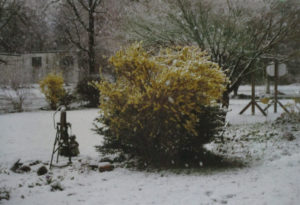
From the Joey Archives: 1996, April 9, Tuesday — Snow on blooming forsythia in Hamilton Square, Mercer County.
SUNRISE AND SUNSET: For the week of Sunday, April 8, Sunday, to Saturday, April 14, the sun will rise from about 6:30 to 6:20 a.m. and set about 7:30 to 7:35 p.m. For the week of Sunday, April 15, to Saturday, April 21, the sun will rise about 6:20 to 6:10 a.m. and set about 7:35 to 7:45 p.m.

Sky photo, No. 1: My backyard in Monroe, Middlesex County.
ATLANTIC OCEAN TEMPERATURE: The Atlantic Ocean temperature off New Jersey was about 45 degrees.
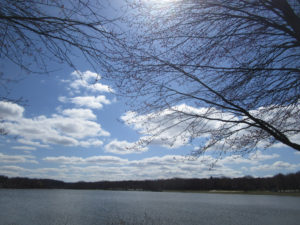
Sky photo, No. 2: “Jamesburg Lake” (properly “Lake Manalapan”) in Thompson Park on the Jamesburg-Monroe boundary of Middlesex County.
WEATHER: The National Weather Service office serving the Jersey Midlands is at https://www.weather.gov/phi/.
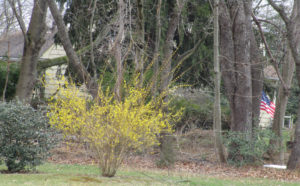
Forsythia blooming in a front yard of a house in East Windsor, Mercer County.
UPCOMING:
April 9 to 15, Monday to Sunday, Mercer County: The annual Princeton Environmental Film Festival, website https://www.princetonlibrary.org/peff/.
April 11, Wednesday, 9 a.m. to 3:30 p.m., Somerset County, Hillsborough: The 10th Annual New Jersey Invasive Species Strike Team Conference, Duke Farms, Route 206. More information is available from the Friends of Hopewell Valley Open Space, email
April 14, Saturday, 9:30 a.m. signup, 10 a.m. to 1 p.m., Middlesex County, East Brunswick: The 15th Annual Farrington Lake Cleanup, Bicentennial Park, Riva Avenue and Hardenburg Lane. (Rain date, April 15, Sunday, 1 to 4 p.m.). More information is available from Michael Shakarjian at telephone 732-828-3275, Alan Godber at 732-846-4476, website http://www.lbwp.org, or email contact@lbwp.org.
April 21, Saturday, 11 a.m. to 2 p.m., Burlington County, Southampton: The Pinelands Preservation Alliance’s 13th Annual Native Plant Sale, Alliance headquarters, 17 Pemberton Road (Route 616). More information is available from the alliance, telephone 609-859-8860 or website http://www.pinelandsalliance.org.
April 28, Saturday, 10 a.m. to 4 p.m., Middlesex County, New Brunswick: Rutgers University Ag Field Day, Cook Campus, Route 1 and Ryders Lane. More information is available at website http://agfieldday.rutgers.edu.
April 28 and 29, Saturday and Sunday, Hunterdon County, Lambertville: Shad Fest event of environmentalism, entertainment, food, crafts. More information is available at http://www.shadfest.com.
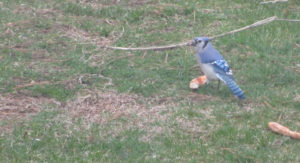
Now, this is a Jersey blue jay, a blue jay, “Cyanocitta cristata,” that eats pizza. In my backyard in Monroe, Middlesex County.
Joe Sapia, 61, is a lifelong resident of Monroe — in South Middlesex County, where his maternal family settled more than 100 years ago. He is a Pine Barrens naturalist and an organic gardener of vegetables and fruit, along with zinnias and roses. He loves the Delaware River north of Trenton and Piedmont, too.
He draws inspiration on the Pine Barrens around Helmetta from his mother, Sophie Onda Sapia, who lived her whole life in these Pines, and his Polish-immigrant grandmother, Annie Poznanski Onda.
He gardens the same backyard plot as did his Grandma Annie and Italian-American father, Joe Sr. Both are inspirations for his food gardening. Ma inspires his rose gardening.
Joe is a semi-retired print journalist of almost 40 years. His work also is at @JosephSapia on Twitter.com, along with The Jersey Midlands page on Facebook.com on the Jersey Midlands page.
Copyright 2018 by Joseph Sapia
Article and photos by Joe Sapia
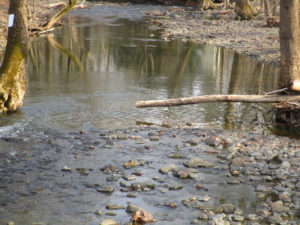
Here at Rock Brook on Sourland Mountain in Montgomery, Somerset County, and in other New Jersey locales, trout fishing formally opens Saturday, April 7, at 8 a.m.
ROCK BROOK: Rock Brook has its headwaters on Sourland Mountain, from which it drains about 3.2 square miles into Beden Brook below the mountain to the east in the area of Skillman Park. Beden Brook, then, crosses Route 206 and flows into the Millstone River between Rocky Hill and Griggstown. These few miles of flow are all in Montgomery, Somerset County. Rock Brook is filled with traprock, one of the characteristics of the Piedmont geologic area.
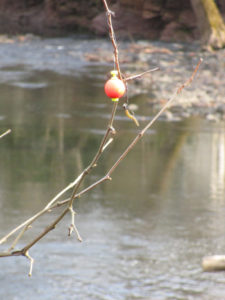
A rite of passage of fishing, getting snagged in a tree. Here, a bobber and lure snagged along Rock Brook at Bessie Grover Memorial Park on Sourland Mountain in Montgomery, Somerset County. Bessie Grover was a local resident. Her history is at http://www.stoutsburgcemetery.org/stories/bessie-grover/.
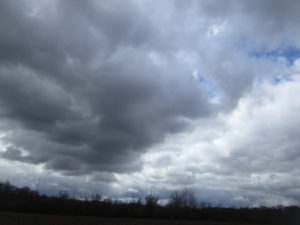
Sky photo 1: East Windsor, Mercer County.
HARRY’S ARMY/NAVY: Harry’s Army/Navy, a military surplus and outdoors retail institution on Route 130, is closing. In the summer of 1974, as I headed to my freshman year at Marquette University’s College of Journalism in Wisconsin, I bought my pea coat at Harry’s for $45. Since, I have bought many a thing: shoes, shirts, denim jacket, neckerchief, belts, T-shirts, knapsack, bright orange safety vest, pocket knife, flashlight…. I am so sad to see Harry’s go. What will I do, now? See http://www.nj.com/mercer/index.ssf/2018/03/post_180.htmland http://www.nj.com/mercer/index.ssf/2018/03/17_things_harrys.html#incart_river_index. Harry’s website, http://harrysan.com.
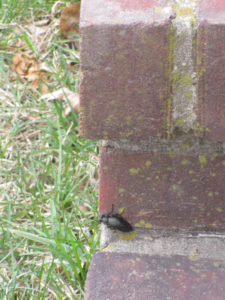
I believe this is an oil beetle, genus “Meloe,” on my back porch in Monroe, Middlesex County. Why “oil”? Because they have a defense of secreting an oily substance.
THE SOUNDS OF SPRING: As I was leaving my house in Monroe, Middlesex County, I heard the cooing of a mourning dove, “Zenaida macroura,” sounding as though it was coming from the Manalapan Brook floodplain’s swamp hardwood forest. Earlier by a day or two, I heard another bird, although I do not know the species, colorfully singing. Then, another bird singing away. Oh, and the spring peeper treefrogs, “Pseudacris crucifer,” are really calling away. This is the sound of spring.

The emergence of this oil beetle on my back porch is another sign of spring.
‘ONION SNOW’: I learned a new term, “onion snow.” It means a snow that comes after onions have been planted and are sprouting or when they should be planted. In other words, a late snow that melts quickly. In New Jersey, the Rutgers University Cooperative Extension advises planting onions in April. So, here we are, with an “onion snow” forecast for the Sunday-Monday, April 1-2, overnight. As for wild onions, they have been sprouting for weeks.

Sky photo 2: Farmland in Monroe, Middlesex County.
SPRING SNOW: A spring snow tends to be wet and heavy. In a recent snow, a pitch pine, “Pinus rigida,” in my backyard in Monroe, Middlesex County, broke. It already was weakened — I noticed what I believe were woodpecker peck marks in it — for whatever reason. The pitch pine is the common pine of the Pine Barrens and I dug up this one in my local woods and transplanted it in my yard. So, it is not normally used as an ornamental. Because it is more forest tree, I am leaving it in place, broken — as it would sit in the woods. I did remove the broken limbs and added them to my brush pile, a favorite place of house sparrows, “Passer domesticus.”
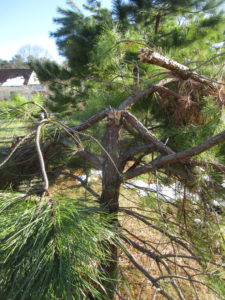
The snow-broken pitch pine in my backyard.
Another view of the snow-broken pitch pine in my backyard.
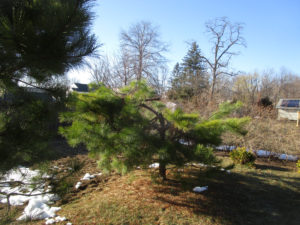

I added the broken branches from the damaged pitch pine to the wildlife bush pile in my backyard.
NO EAGLETS AT DUKE FARMS: I have been watching the live camera on the Duke Farms nest of bald eagles, “Haliaeetus leucocephalus,” pre-nor’easter snow, during a nor’easter, and after a nor-easter. During a nor’easter, an eagle covered in snow sat on an egg or eggs. Sadly the nest at Duke Farms in Hillsborough, Somerset County, is done for the season, with no successful hatching of the two eggs. See the story at http://www.nj.com/somerset/index.ssf/2018/03/duke_farm_devastated_after_eagle_cam_nest_fails.html. This means the Duke Farms nest is done for the season.
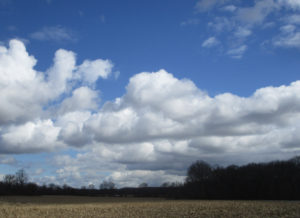
Sky Photo 3: Farmland in Monroe, Middlesex County.
UPPER MILLSTONE RIVER EAGLES: For a few weeks now, the bald eagles, “Haliaeetus leucocephalus,” at the Upper Millstone River nest on the boundary of Middlesex and Mercer counties have been feeding a chick or chicks. This was based on watching the adults, either standing high on the nest or flying in or out frequently — as if they were taking care of, feeding, an eaglet or more than one. This week, Ann Price, my fellow volunteer nest monitor, “saw the adult feeding the chick/s. I did catch a glimpse of an eaglet. No idea how many are there. But I can confirm one.”

Sky photo 4: Farmland in Monroe, Middlesex County.
MYSTERY OF THE BIG CATS: Recently, there have been reports of a mystery big cat in Ewing, Mercer County, and Helmetta, Middlesex County. Mountain lion? Doubtful. Bobcat? Maybe. Domestic cat? Probably. These mystery big cat sightings happen every so often. During my newspaper reporting days, I kept a file on them. Normally, they never amount to anything conclusive.
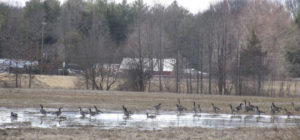
Canada geese, “Branta canadensis,” at a puddle on farmland in Monroe, Middlesex County.
SUNRISE AND SUNSET: For the week of Sunday, April 1, to Saturday, April 7, the sun will rise about 6:40 to 6:30 a.m. and set about 7:20 to 7:30 p.m. For the week of Sunday, April 8, Sunday, to Saturday, April 14, the sun will rise from about 6:30 to 6:20 a.m. and set about 7:30 to 7:35 p.m.
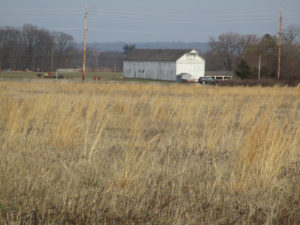
A field of Indian grass in Montgomery, Somerset County.
ATLANTIC OCEAN TEMPERATURE: The Atlantic Ocean temperature off New Jersey is about 45 degrees.

An eastern bluebird, “Sialia sialis,” sits on a snowfence post in Montgomery, Somerset County. It is a male, identifiable because of its bright colors.
WEATHER: The National Weather Service office serving the Jersey Midlands is at https://www.weather.gov/phi/.
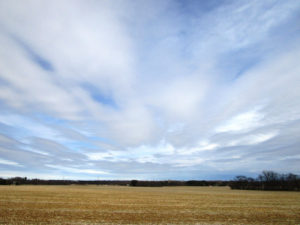
Sky photo 5: Farmland in Monroe, Middlesex County.
UPCOMING:
April 9 to 15, Monday to Sunday, Mercer County: The annual Princeton Environmental Film Festival, https://www.princetonlibrary.org/peff/.
HEARINGS ON GAS PIPELINE EXPANSION: The Federal Energy Regulatory Commission (FERC) has schedule hearings on the “draft environmental impact statement” for the Northeast Supply Enhancement project’s natural gas pipeline expansion through the Jersey Midlands. Hearings are scheduled for:
April 25, Wednesday, 5 to 9 p.m., in Middlesex County, Old Bridge, at the George Bush Senior Center.
April 26, Thursday, 5 to 9 p.m., in Brooklyn, New York, at the Best Western Gregory Hotel.
May 2, Wednesday, 5 to 9 p.m., in Somerset County, Franklin, at the Franklin Township Community Center.
May 3, Thursday, 5 to 9 p.m., in Quarryville, Pennsylvania, at Solanco High School.

Sunset in my backyard in Monroe, Middlesex County.
Joe Sapia, 61, is a lifelong resident of Monroe — in South Middlesex County, where his maternal family settled more than 100 years ago. He is a Pine Barrens naturalist and an organic gardener of vegetables and fruit, along with zinnias and roses. He loves the Delaware River north of Trenton and Piedmont, too.
He draws inspiration on the Pine Barrens around Helmetta from his mother, Sophie Onda Sapia, who lived her whole life in these Pines, and his Polish-immigrant grandmother, Annie Poznanski Onda.
He gardens the same backyard plot as did his Grandma Annie and Italian-American father, Joe Sr. Both are inspirations for his food gardening. Ma inspires his rose gardening.
Joe is a semi-retired print journalist of almost 40 years. His work also is at @JosephSapia on Twitter.com, along with Facebook.com on the Jersey Midlands page.
Copyright 2018 by Joseph Sapia
Article and photos by Joe Mish

The sea run shad, striped bass and herring that gather at the mouth of the Raritan River attract animals high on the food chain such as this harbor seal. Whales and dolphin have also been sighted over the last few years not in small part from the contribution of the Raritan River and its sweet water branches.
The spring-fed north and south branches of the Raritan River join in a marriage of sweet water at their confluence, on an endless journey to the sea. Each hidden spring and brook along the way, contributes its own genetic identity, mixed in a final blend at the mouth of the Raritan River.
Where the fresh water meets the salty sea, the ebb and flow of tides stir the brine into fresh water to create a stable buffer zone of brackish water.
These back bays and estuaries formed at the mouths of rivers are a perfect place for young of the year striped bass to gain in size before going offshore to migrate. American, hickory, gizzard shad, river herring, such as blueback herring and alewives also gather here and search for ancient breeding grounds located far upriver.
In the time before dams, sea run fish migrated far upstream into the north and south branch. Fishing was a robust industry in early colonial times where the seasonal migration of herring and shad was a profitable business.
The construction of dams to power mills along the river put a halt to upstream commercial fishing. The mills and dams were not welcomed by colonists who made a living from the seasonal fisheries. One account tells of early settlers in the mid 1700s, unhappy with a mill dam just below Bound Brook, making nightly raids to dismantle the dam and allow shad to continue their upstream migration.
Fast forward to today, the river still flows to the sea and the shad and herring gather to swim upstream.
In 1985 pregnant shad from the Delaware River were transplanted to the South Branch as part of a program to restore a shad migration along with planned dam removals.
Dams that have blocked migrating fish have recently been removed. The Calco dam near the former Calco Chemical Company built around 1938, cleared the way for migrating fish to reach the confluence of the Millstone and Raritan where a flood control dam was built. Known as the Island Farm weir, completed in 1995, it includes a viewing window and fish ladder to allow the dam to be bypassed by fish travelling upstream.
As part of the shad restoration project, volunteers working with Rutgers scientists tag shad and herring in an ongoing effort to gauge the success of the fish ladder and restoration efforts. Preliminary findings can be accessed at, http://raritan.rutgers.edu/wp-content/uploads/2015/10/NJDEP-2013-American-shad-restoration-in-the-raritan-river.pdf
A live underwater camera is placed at the dam each year after threat of ice has past. The camera is now operated by Rutgers University and may be seen online at http://raritanfishcam.weebly.com/fish-guide.html and at http://raritan.rutgers.edu/resources/fish-cam/
Aside from the Calco dam, three of five dams upstream of the Island Farm Weir, two dams on the Raritan, the Nevius street and Robert street dam and one on the Millstone have been removed. All in anticipation that the head dam at Dukes Island Park and the low dam at Rockafellows Mills on the South Branch will eventually be deconstructed.
See the above link for the video of the Nevius street dam removal. Go to MENU, open videos/multimedia to see Nevius street dam deconstructed.
See this link for a look at the Duke’s Island dam today; https://vimeo.com/259404286
The dream to restore our rivers and fisheries to their unmolested glory is well on the way to reality. Bald eagles now nest along the Raritan and its branches, soon to be joined by spawning shad and herring.
The vision of a pristine river valley, interrupted by 300 years of abuse and neglect is slowly emerging from the river mist as a magical apparition. The magic supplied by the hard work of Rutgers scientists and dedicated volunteers who echo the words of Rutgers president Thomas, who served in 1930, “Save the Raritan”.
As an aside to this article, I will share a sobering and emotional experience involving the Island Weir Dam that took place in 1995. The intent is to emphasize the importance of safety while paddling in general and especially when near dams or in cold water.
See page three of this link for a description of what happened that day: http://www.wrightwater.com/assets/25-public-safety-at-low-head-dams.pdf
I was paddling on the Delaware and Raritan Canal which parallels the Millstone River about two miles from where the dam is located at the confluence of the Millstone and Raritan rivers. This was a training session for a cold water canoe race that takes place each April in Maine. I am an experienced paddler, familiar with cold water immersion and so was wearing a wet suit with a dry top and pants along with a life jacket/pfd while on the calm water in the canal.
As I neared the end of my trip at the Manville causeway, several police cars slowly drove by and turned around as if searching for something. Sirens were wailing and more police and rescue vehicles were seen and the road blocked off. First thought was the body of a woman who was reported to have ended her life in the Millstone a week before was found.
As it turned out a kayaker and two companions in a canoe decided to run the dam. According to my recollection of the news article; the canoe made it through first, while the kayaker who followed, failed to clear the dam and was stuck in the hydraulic.
According to the news article, ‘the experienced paddlers’ wore no thermal protection or pfds when they ran the dangerous dam. It was reported that the canoers paddled back to help their companion and they capsized in the hydraulic. Once you cross that line which marks the downstream flow from the water cycling upstream, you will be pulled into the hydraulic.
The kayaker and one of the men in the canoe were washed out of the turbulent water but the other was lost, his body never recovered.
A hydraulic occurs when the weight of falling water creates a hole which is then filled by downstream water being pulled upstream in an endless re-circulating current parallel to the dam. Low head dams may be altered to prevent or mitigate a hydraulic.
There is a point of no return where you can actually see a line that separates the water flowing downstream from the water flowing back upstream to power the hydraulic.
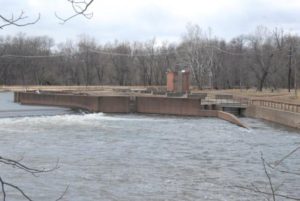
Island Weir Dam at the confluence of the millstone and Raritan River. You can see the horizontal shelves that are the fish ladder in the center and the subsequent stepped redesign to mitigate the dangerous hydraulic.
There have been several more drownings involving dams on the Raritan and its branches. I recall another at the Headgate, which is the dam created by the Duke estate below the confluence of the North and South branches. The paddler went over and was lost in the hydraulic below.

This is the headgate dam at Dukes Island Park. Created to collect river water via the Dukes canal to power the estates and supply water to the series of ponds built at decreasing elevations to allow the water to return to the river by gravity.

No warning signs are posted to alert paddlers to the danger ahead. On the downstream face of the dam is a warning to keep off.

Too little too late warning.
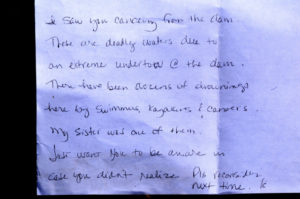
Paddling on the South Branch from Rockafellow’s mill rd, just below the low head dam that forms Red Rock Lake, this note was placed on my windshield. Though I was no where near the dam, contrary to what the note states, the message was at once heart breaking and shown here, now serves as a warning to all; beware of the dangers of low head dams.

This sign is placed about 5 football fields above the dam at red rock lake on the South Branch. It’s placement a puzzlement that mitigates its message.
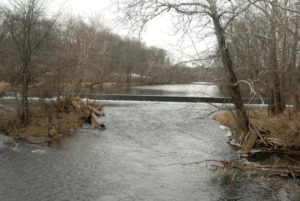
Dam at Red Rock Lake.
Though rivers like the South Branch and North Branch are reputed to be no more dangerous than a swimming pool, tragedy can strike when least expected. Strainers, trees that fall into the river blocking passage, can snag and capsize a boat and entangle the paddler in its branches under pressure of a fast current. Low head dams can drown a paddler by immersion or entanglement on debris as the paddler is unable to wash out of the turbulent recycling water. Search on line to get an idea of how widespread is the danger of obscure low head dams and loss of life across the country.
Paddling when river temperatures are well below normal body temperature requires thermal protection no matter the air temperature. Wearing a pfd alone will not be enough to survive if your body temperature drops before you can be rescued or self rescue. Such was the case of a paddler on Round Valley reservoir a few years ago.
Typically water temp during the winter and early spring on the South Branch is 41 degrees. More than enough to cause a spasm to block your ability to breathe even before hypothermia sets in. See this link for a detailed explanation of the effects of cold water immersion. Remember, ‘cold water’ does not have to be that cold.
http://www.coldwatersafety.org/ColdShock.html
Overturning in fast water, a boat can instantly fill with a hundred gallons of water. Each gallon weighing 8 pounds, can pin or crush a paddler between the canoe and any obstruction. Such was the case on a locally sponsored canoe trip in shallow water on a beautiful day on the South Branch. One paddler was trapped under the canoe in a strainer. Eventually he popped out from under the boat, shaken but safe. The canoe was stuck fast in the strainer, filled with hundreds of pounds of water. Never be downstream of a capsized canoe.
Tragedy can occur on the calmest day under brilliant blue skies, always wear a pfd and be alert to potential dangers, especially dams.
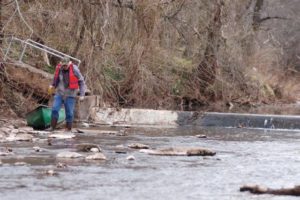
Low head dam across the North Branch just above rt 202 makes a difficult passage during low water portage and a dangerous hydraulic during high water.
Author Joe Mish has been running wild in New Jersey since childhood when he found ways to escape his mother’s watchful eyes. He continues to trek the swamps, rivers and thickets seeking to share, with the residents and visitors, all of the state’s natural beauty hidden within full view. To read more of his writing and view more of his gorgeous photographs visit Winter Bear Rising, his wordpress blog. Joe’s series “Nature on the Raritan, Hidden in Plain View” runs monthly as part of the LRWP “Voices of the Watershed” series. Writing and photos used with permission from the author.
Article and photos by Joe Sapia
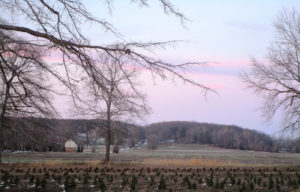
Arneys Mount in Springfield, Burlington County.
ARNEYS MOUNT: Arneys Mount stands roughly 245 feet above sea level, or about 175 feet above the surrounding lowland, in Springfield, Burlington County. It is part of the cuesta geologic formation — hills that have survived erosion and now separate New Jersey’s Outer Coastal Plain and Inner Coastal Plain. Take a map a draw a line from Sandy Hook at the Atlantic Ocean in Monmouth County to the Burlington County area of Mount Holly-Mount Laurel. That line is essentially the line of the cuesta. On a detailed map of that line, you will see names representing the hill system — Highlands, Mount Mitchell, Crawford Hill, Telegraph Hill, Beacon Hill, Knob Hill, Locust Hill, Quail Hill, Pine Hill, Backbone Hill, Disbrow Hill, Crematory Hill, Stone Hill, Arneys Mount, Mount Holly, and Mount Laurel.
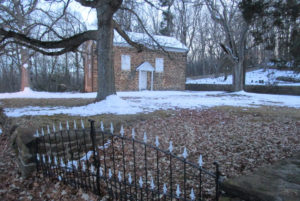
The circa 1775 Arneys Mount Friends Meeting House.
VOICES FROM AFIELD NO. 1, THE CUESTA: Cousin Jerry Edvy lives on high ground just outside of Perrineville in Millstone, Monmouth County. When it snowed during the Tuesday, March 13, nor’easter, he reported “at least 5 inches.” His house is on the cuesta, or about 280 feet above sea level. When Jerry drove off the cuesta, he saw hardly any snow. “(Route) 33 was clear,” said Jerry, speaking of the road about 3 miles north of his house. “We must have got hit with a band,” he said. Or maybe it was just the height of his area. My house, about 50 feet above sea level about 10 miles to the north, got only about 1 inch of snow. I recall this cuesta-lowland dichotomy several years ago during my newspaper reporting days for the Asbury Park Press as I drove in Monmouth County from the Millstone area to the Sandy Hook area — when I was on high points of the cuesta, there was a covering of snow, maybe a few inches; when I was at lower elevations, maybe just a coating. An interesting phenomena happening in only a matter of dozens of feet.
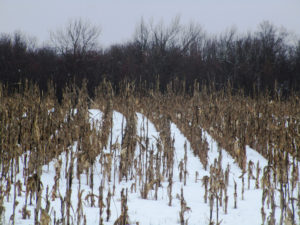
The Tuesday, March 13, nor’easter snowfall in a Monroe Township, Middlesex County, cornfield.
SNOWFALL: The seasonal snowfall tally at my house in the part of Monroe between Jamesburg and Helmetta is 29.0 inches. The average seasonal snowfall in New Brunswick, about 7.5 miles away, is about 26 inches. So, based on that, we are about 3 inches more than normal at my house, with about a month’s worth of snowfall season left.
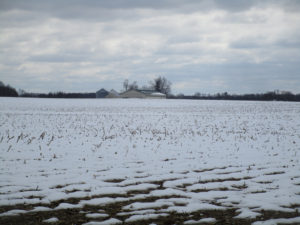
The Tuesday, March 13, nor’easter snowfall at a farm in Plainsboro, Middlesex County.
FOREST FIRE SEASON: Because of the wet weather, the Pine Barrens spring wildfire season in the Jersey Midlands is running behind this year. Normally, it runs March 15 to May 15, when winds blow, humidity decreases, temperatures rise, and sun penetrates the essentially leafless forest, warming and drying the duff. But with the wetness out there, for example, the state Forest Fire Service canceled a control-burn for the upcoming week in the Jamesburg Park Conservation Area in Middlesex County.
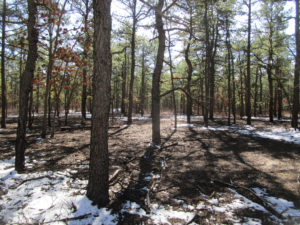
Snow on the ground in the Pine Barrens of Barnegat, Ocean County.
FIRE TOWERS: The idea of a fire tower is to see smoke during daylight hours, basically to dispatch firefighters before a fire really gets going. Because once flames are seen, the fire is well underway. The state Forest Fire Service has eight wildfire lookout towers in the Jersey Midlands — Apple Pie Hill, Bass River, Batsto, Lebanon, and Medford, all in Burlington County; Cedar Bridge and Lakewood, both in Ocean County; and Jamesburg, Middlesex County. When the fire towers are staffed, the public is welcome to visit. Beware, though, it can be a climb of about 60 to 100 feet, depending on the tower.
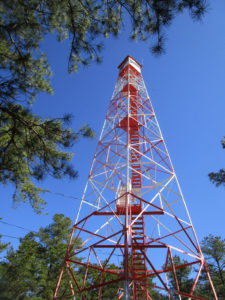
BASS RIVER STATE FOREST: Trees are to be cut around the Bass River fire-lookout tower in Bass River State Forest to improve the view for the tower observer. See https://thesandpaper.villagesoup.com/p/clear-cutting-proposed-for-bass-river-state-forest-fire-protection/1729679.
PYGMY PINES: Generally in the area of the intersection of Routes 72 and 539 in Ocean County stand hundreds of acres of Pine Barrens forest with trees perhaps only 8-feet-tall at most. This is the “Pygmy Pines” or “The Plains.” The theory is the stunted growth in this area is caused by repeated fires.
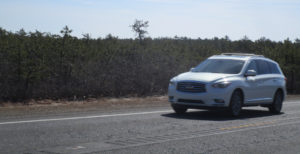
A sport utility vehicle drives on Route 539 through the Pygmy Pines, or Plains, in the Pine Barrens outside of Warren Grove, Ocean County.
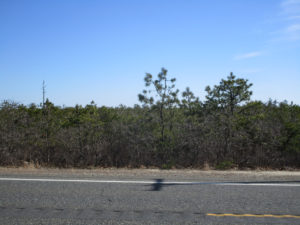
The Pygmy Pines, or Plains, on Route 539 in the Pine Barrens near Warren Grove, Ocean County.
WITCH’S BROOM: If you regularly walk the Pine Barrens, you are likely to have seen a “witch’s broom,” a thick growth of needles on a pitch pine, “Pinus rigida.” While it may look haunting, it is simply caused by disease, defect, infestation, or environmental stress.
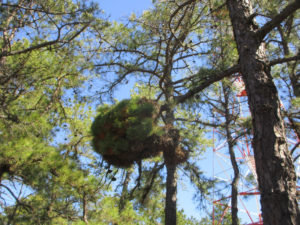
A “witch’s broom” growth on a pitch pine, “Pinus rigida,” at the Cedar Bridge fire-lookout tower in Barnegat, Ocean County.
PAINTED ROCK IN THE PINE BARRENS: Going back years, a rock along Route 539, on the section between Routes 70 and 72 in Lacey, Ocean County, had been painted in different ways according to the calendar — a Halloween jack-o-lantern, a turkey for Thanksgiving, and so on. But the rock, apparently on its way by truck to the Jersey Shore for erosion control when it somehow wound up along the road, took on an American flag, patriotic theme after 9-11 — the 2001, September 11, Tuesday, terrorist attack on American soil. No matter the artwork, the rock remains a landmark in the Pine Barrens. For more information on the rock, see http://www.jamesrahn.com/pages/other/personal/rock.htm.
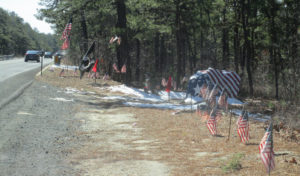
Since around 9-11 — the terrorist attack on American soil on 2001, September 11, Tuesday — the rock on Route 539 in the Pine Barrens of Lacey, Ocean, has taken on a patriotic theme.
PROTECTED ‘PINELANDS’: While much of the Pine Barrens is protected by state “Pinelands” regulations, it is not true the Pine Barrens are fully preserved. One, not all the Pine Barrens is regulated for environmental protection. Two, building is allowed even in the regulated area.

The (un)American way, development in the Pine Barrens, here in Whiting, Ocean County.
CROSSWICKS CREEK: Crosswicks Creek’s headwaters are in the area of New Egypt, Ocean County. It, then, flows into the Delaware River at Bordentown. The federal Geological Survey has a gauge along Crosswicks Creek at Extonville on the boundary of Burlington and Mercer counties, https://waterdata.usgs.gov/nwis/uv/?site_no=01464500. Along the waterway is Crosswicks Creek Park, part of the Monmouth County Park System, https://www.monmouthcountyparks.com/page.aspx?Id=2568.
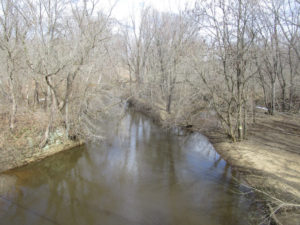
Looking upstream on Crosswicks Creek, here on the boundary of Mercer County to the left and Burlington County to the right. Here, Crosswicks Creek separates the villages of North Crosswicks in Hamilton, Mercer County, and Crosswicks in Chesterfield, Burlington County.
READING THE ENVIRONMENT: When walking afield, let the land talk to you. It has a historical record. For example, the other day I was telling Eric Gehring, a naturalist for the Middlesex County Office of Parks and Recreation, about the dikes in the woods across Manalapan Brook from my house. Those dikes are a record of the area’s cranberry farming that ended around World War II. Then, during the week, on a portion of Manalapan Brook about 4 miles south of my house, I noticed wood planks sticking out of the ground. Remnants of a bridge? A dam? This remains a mystery.
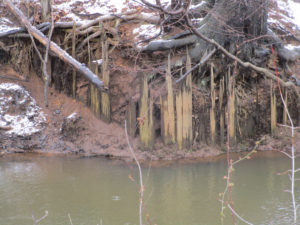
Remnants of a wooden structure on Manalapan Brook in southern Monroe, Middlesex County.
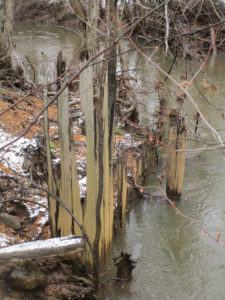
The wooden remnants on Manalapan Brook in southern Monroe, Middlesex County.
VOICES FROM AFIELD NO. 2, A MINK: Frank Ulatowski, an Englishtown-Manalapan outdoorsman, reported seeing a roadkilll of mink, “Mustela vison,” on Route 33 in Monroe, Middlesex County. So, mink are around.
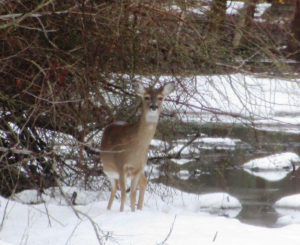
I came across this deer, “Odocoileus virginianus,” on a utility line on the boundary of Hightstown and East Windsor in Mercer County. Deer live on the edge — the edge of the woods, where they seek refuge, and fields, where they browse.
CHANJ: The state Division of Fish and Wildlife is promoting its initiative of CHANJ — Connecting Habitat Across New Jersey. CHANJ is looking to protect habitat and connect habitat through such things as land purchase, management of land, and safe wildlife passage at roadways. Roadway mitigation could include using culverts and bridges to have a safe pathway for wildlife to cross roads. The idea is have connectivity using core areas, which could be as little as 200 acres to as big as state regions such as the Highlands of North Jersey and, locally, the Pine Barrens.
UPPER MILLSTONE RIVER EAGLES: It appears the pair of bald eagles, “Haliaeetus leucocephalus,” are feeding chicks in the Upper Millstone River nest on the boundary of Mercer and Middlesex counties, based on one adult on the nest while another flies to it. See the series of photographs:
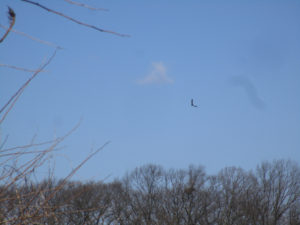
Photo 1: An adult bald eagle circles the Upper Millstone River nest, which is below the eagle.
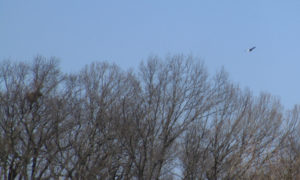 Photo 2: The eagle continues to circle, its white tail easily seen in this photograph. The nest is to the left.
Photo 2: The eagle continues to circle, its white tail easily seen in this photograph. The nest is to the left.
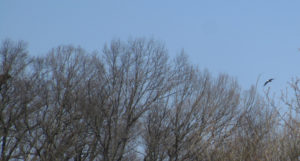
Photo 3: The eagle circles back toward the nest, which is to the left, its white head clearly seen.
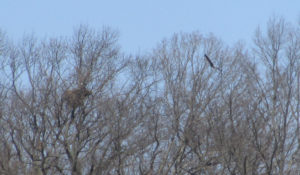
Photo 4: The eagle flies toward the nest, which is to the left, where its mate awaits. The mate’s head is the speck of white above the nest.
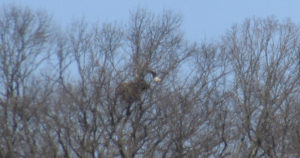
Photo 5: The eagle is landing on the nest, its mate awaiting.
VOICES FROM AFIELD NO. 3, UPPER MILLSTONE RIVER EAGLES: Frank Ulatowski, an outdoorsman from Englishtown-Manalapan, and his wife, Charlene, were visiting a business in the area of the Upper Millstone River nest of bald eagles, “Haliaeetus leucocephalus,” on the boundary of Mercer and Middlesex counties when a bald eagle flew by near the top of one of the single-story buildings. Frank wondered with all people around, how many noticed the eagle — as breeders in New Jersey, bald eagles are “endangered,” or under immediate peril, and, in general, “threatened,” or a species that can become “endangered” if conditions continue.
DUKE FARMS EAGLE CAMERA: At Duke Farms in Hillsborough, Somerset County, bald eagles, “Haliaeetus leucocephalus,” are sitting on two eggs, the first of which is scheduled to hatch about Wednesday, March 21. There is a live-stream camera on the nest that can be seen at http://dukefarms.org/making-an-impact/eagle-cam/. In New Jersey, bald eagles are “endangered,” or under immediate peril, as breeders and, in general, “threatened,” or a species that can become “endangered” if conditions continue.
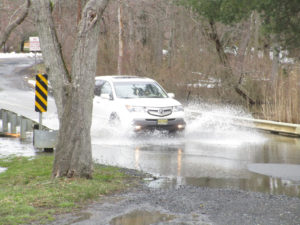
The March 13, Tuesday, nor’easter flooding on the boundary of Plainsboro and South Brunswick, Middlesex County.
BATSTO LAKE: Batsto Lake in Wharton State Forest, Burlington County, is formed by the damming of the Batsto River. The lake is 40 acres, according to the New Jersey Fish Finder website. As for the river, it drains 67.8 square miles, according to the federal Geological Survey.
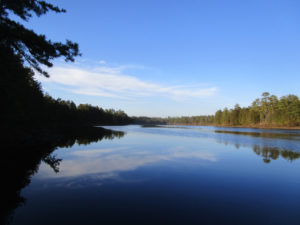
Batsto River in Wharton State Forest, Burlington County.
SIGNS OF THE PINES: While traveling through the main part of the Pine Barrens, I came across a few interesting signs, both in the Bass River State Forest area of Burlington County:

A folk art sign warning drivers of deer, “Odocoileus virginianus,” crossing a road near Bass River State Forest in Burlington County.

An old masonry advertising style — formerly announcing a winery, now advertising property for sale — on Route 9 near Bass River State Forest in Burlington County.
SKY VIEWS: This week’s sky views are from Hamilton, Mercer County, and Monroe, Middlesex County.

Farmland in Hamilton, Mercer County.
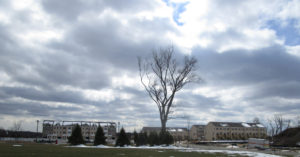
Mounts Mills Road in Monroe, Middlesex County.
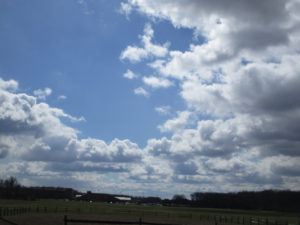
Thompson Park, looking at Monroe High School, in Monroe, Middlesex County.
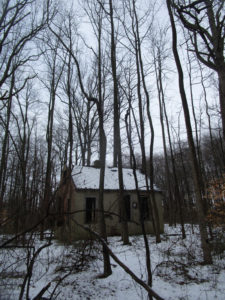
An abandoned cabin in the woods of Monroe, Middlesex County.
Joe Sapia, 61, is a lifelong resident of Monroe — in South Middlesex County, where his maternal family settled more than 100 years ago. He is a Pine Barrens naturalist and an organic gardener of vegetables and fruit, along with zinnias and roses. He loves the Delaware River north of Trenton and Piedmont, too.
He draws inspiration on the Pine Barrens around Helmetta from his mother, Sophie Onda Sapia, who lived her whole life in these Pines, and his Polish-immigrant grandmother, Annie Poznanski Onda.
He gardens the same backyard plot as did his Grandma Annie and Italian-American father, Joe Sr. Both are inspirations for his food gardening. Ma inspires his rose gardening.
Joe is a semi-retired print journalist of almost 40 years. His work also is at @JosephSapia on Twitter.com, along with Facebook.com on the Jersey Midlands page.
Copyright 2018 by Joseph Sapia
Article and photos by Joe Mish
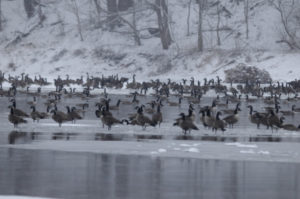 Canada Geese in a snowstorm on the South Branch appear at ease as the falling snow softens the scene.
Canada Geese in a snowstorm on the South Branch appear at ease as the falling snow softens the scene.
The January blizzard raged, turning the darkness into an opaque curtain of white. Almost a foot of powdered snow covered the ground before midnight.
The broadcast news reported that NJ had declared a state of emergency shutting down roadways throughout the state. The setting was just right for the midwinter parade on the South Branch. Thousands attended and the main thoroughfare was jammed with local residents and visitors. As I stepped outside to get a head start on clearing the driveway, the sound of geese, thousands of geese, overpowered the drone of the wind driven snow. So impressive was the magnitude of the unalarmed chatter, I was compelled to investigate. Alerting my family where to search for the body, I headed into the storm.
The closer I got to the river the louder and more beckoning the sound became. Moving slowly through the trees toward the river bank, the din from the geese on the open water was deafening. The river was filled wall to wall with migrant and resident Canada geese. Some started to get up and fly. Others just drifted by. All appeared as black silhouettes against the snow and reflective water. Thousands upon thousands all in chorus, the rhythm and sound of their calls rose and fell as if one voice. Occasionally all sound would hesitate into a moment of absolute silence. The silence was as dramatic as the din.
Animals generally become fearless in extreme weather and at the height of this snowstorm the geese collectively tolerated my close approach.
As I closed in, the birds parted, momentarily leaving a void of reflective water. The surface was again soon covered with geese as the specter of an interloper was confidently dismissed.
The Geese were packed so tight; they appeared as if in a big cauldron that was being stirred. One group was drifting down with the current while the other was going back up stream in a re-circulating eddy below the island.
Aside from the geese, the river was filled with joined platelets of gray and white ice, strong enough to support several of the large birds. A display of motionless geese rode atop drifting ice flows, escorted by a cadre of even more geese floating alongside, all travelling at the same speed.
This looked all so familiar. Suddenly it struck me. I could have been watching a fourth of July parade with themed floats and accompanying marchers. Certainly the band was playing a familiar tune as spectator geese lined the banks and joined in the chorus.
How odd that here was a gathering of what seemed to be all the geese in New Jersey having their own parade. As if to celebrate some event sacred to the hearts of all geese, each bird taking comfort in knowing they owned the night and there would be no human eyes to witness their ethereal rite.
Author Joe Mish has been running wild in New Jersey since childhood when he found ways to escape his mother’s watchful eyes. He continues to trek the swamps, rivers and thickets seeking to share, with the residents and visitors, all of the state’s natural beauty hidden within full view. To read more of his writing and view more of his gorgeous photographs visit Winter Bear Rising, his wordpress blog. Joe’s series “Nature on the Raritan, Hidden in Plain View” runs monthly as part of the LRWP “Voices of the Watershed” series. Writing and photos used with permission from the author.
Article and photos by Joe Sapia

A nanny with two of her three new kids at Cranbury Brook Farm in Monroe, Middlesex County.
NEW KIDS IN TOWN: A few days ago, Laurie Ann Kozinsky Winter welcomed three “kids” to her Cranbury Brook Farm in Monroe — that is, three baby goats. On Sunday, March 4, Laurie Ann opened up her farm for a few hours so the community could visit the kids (all females) and their mom, the nanny.
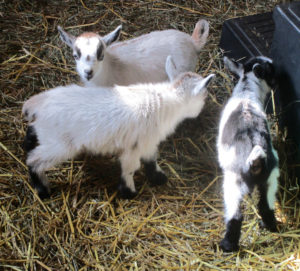
The three young ladies at Cranbury Brook Farm.
As a lifelong Monroe resident of 61 years, I have watched the township of a little more than 43 square miles grow from an estimated 5,000 people to today’s estimated 50,000. So, today’s visit to the farm, which sits on Cranbury Brook, was a visit back in time — when the part of Monroe south of Jamesburg was simply “The Farms.”

A mother’s care at Cranbury Brook Farm.
My maternal Onda-Poznanski family and Laurie Ann’s maternal side have know each other for a hundred or so years. Laurie Ann’s maternal grandmother, Anna Kozinsky, and I lived in the same Helmetta Road area of Monroe. Laurie Ann and I are four days apart in age — Grrrrrr, I am the older one — and attended Holy Trinity Church in Helmetta and St. Mary School in South River — both Polish-Catholic institutions for us good Polski-Catholic children. At the farm, I got to talk to some of Laurie Ann’s children and caught up with her parents, Anna and Danny Kozinsky. So, it was a reunion of families, too.
What was supposed to be a short stay turned into about three hours — and about 120 photographs.

1967, January — Little Laurie Ann and little Joey, both 10-years-old, in the 5th grade at St. Mary School, South River, Middlesex County, where good Polish-Catholic kids went to school.
SHOUT OUT TO FARMER LAURIE ANN KOZINSKY WINTER: The GOAT (Greatest of All Time) — farm owner Laurie Ann Kozinsky Winter. Or as I call her, Princess Winter Spring Summer Fall. (Baby-boomers would understand the Princess moniker — and notice the mix-up of words.) A shout-out to Laurie Ann — A loving wife who lost her husband, Greg, over the summer after a long battle with cancer; she is very dedicated to her elderly parents; and she is a mother and grandmother. A Jersey Girl!
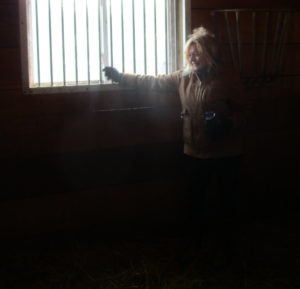
Laurie Ann Kozinsky Winter, owner of Cranbury Brook Farm in Monroe, Middlesex County.
MARCH 1 to 3 NOR’EASTER: We were still cleaning up from the March 1 to 3 nor’easter…
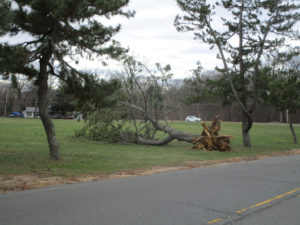
Here in Thompson Park in Monroe, Middlesex County, this fallen tree was a victim of the March 1 to 3 nor’easter. Then, on Wednesday, March 7, we got hit with another nor’easter…
MARCH 7 NOR’EASTER: Meteorologists were having trouble forecasting snow totals for the Wednesday, March 7, nor’easter. Where would the rain/snow line be? A difference of only a few miles could mean a drastic difference in snowfall — Look at the following figures from Somerset County, a 15-inch difference! The National Weather Service reported the following snowfall totals by county. I am listing the reported highs and lows. Keep in mind this may be an incomplete report:
Burlington County: 3.3 inches at Pemberton to 9.5 inches at Moorestown and Cinnaminson.
Hunterdon County: 6.0 in East Amwell to 15.5 in the Stockton area.
Mercer County: 6.1 in the Trenton-Ewing area to 11.5 at Hamilton.
Middlesex County: 2.0 in the Old Bridge area to 9.4 at Cranbury. (I recorded an estimated 6.0 at the part of Monroe between Helmetta and Jamesburg.)
Monmouth County: 1.3 at Keyport to 7.6 in the Upper Freehold area.
Ocean County: 0.4 at Lacey to 3.2 in the Jackson area.
Somerset County: 7.1 at Somerville to 22.0 at Green Brook.
Bucks County, Pennsylvania: 6.5 in the Oakford area to 11.1 in Langhorne.
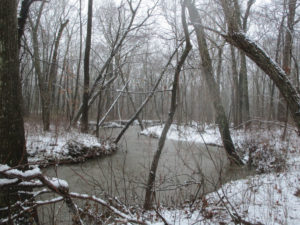
The S-curve of Manalapan Brook in Monroe, Middlesex County, known as the “Old Swimming Hole.”
SNOWFALL: With the Wednesday, March 7, nor’easter, where I live — in the Helmetta-Monroe-Jamesburg area of Middlesex county — has surpassed the seasonal snowfall average. The nor’reaster dropped 6 inches, bringing the seasonal total to 28 inches. Normal would be about 26 inches, based in New Brunswick about 7.5 miles away. And we still have about 4 weeks left in the snowfall season.
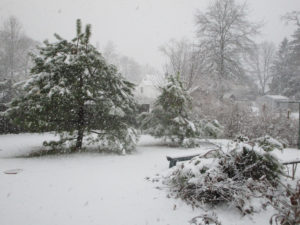
A March 7 nor’easter scene in my backyard in Monroe, Middlesex County.
OTHER SCENES FROM THE MARCH 7 NOR’EASTER:
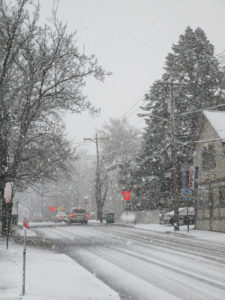
The snow begins in Hightstown, Mercer County.

A Monmouth County Department of Public Works And Engineering plow on Route 571 in the part of Millstone, Monmouth County, between Roosevelt and ETRA.
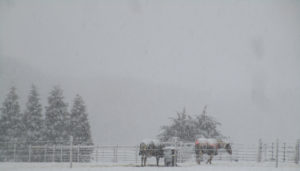
Horses in Roosevelt, Monmouth County.
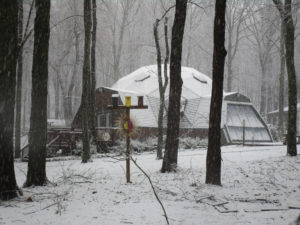
One of the famed geodisic dome houses in Roosevelt, Monmouth County.
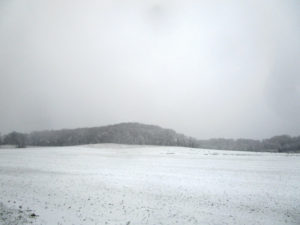
Disbrow Hill, or “Crematory Hill,” in Millstone, Monmouth County.
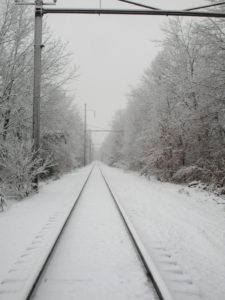
ConRail freight railroad tracks in the part of Monroe, Middlesex County, between Jamesburg and Helmetta.
HOW THESE NOR’EASTERS LIVE ON: We may not realize it, but we will see remnants of Wednesday’s nor’easter for years to come in fallen or bent trees, because of the high wind and the heavy, wet spring snow.
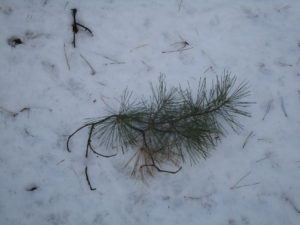
A branch of a pitch pine, “Pinus rigida,” that fell because of the March 7 nor’easter in an East Brunswick section of the Middlesex County Department of Parks and Recreation-operated Jamesburg Park Conservation Area. This is part of my beloved Pine Barrens around Helmetta.
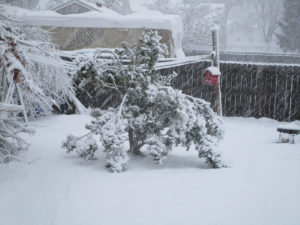
The heavy, wet spring snow bent this American holly, “Ilex opaca,” in my backyard in Monroe, Middlesex County. In heavy snows, I knock the snow off trees and shrubs in my yard.
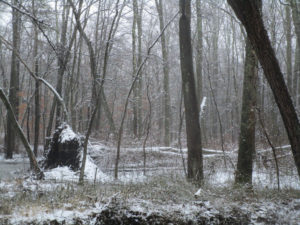
This swamp hardwood tree, about 60 feet in length, fell recently in the Manalapan Brook floodplan in Monroe, Middlesex County. The root pan is about 10-feet-tall. This is in woods I walk and I note trees that are lying to the west are probably remnants of 2012’s Superstorm Sandy, whose winds blew west, rather than the normal wind coming out of the west.
SIGNS OF SPRING: I have noticed male red-winged blackbirds, “Agelaius phoeniceus,” beginning to show their yellow and red epaulets, which they use to attract a female and likely signal territory. According to Cornell University’s All About Birds website, “The Red-winged Blackbird is a highly polygynous species, meaning males have many female mates – up to 15 in some cases. In some populations 90 percent of territorial males have more than one female nesting on their territories. But all is not as it seems: one-quarter to one-half of nestlings turn out to have been sired by someone other than the territorial male.”

A male red-winged blackbird is beginning to show his yellow and red epaulet, a sign of the mating season. This one was in a common position, feeding on the ground below a birdfeeder — in this case in my backyard in Monroe, Middlesex County.
WINTERING DUCKS: During the winter season, it is fun to see what is down here from the north. At Helmetta Pond in Middlesex County, I saw ducks of the genus “Aythya.”
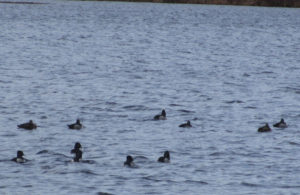
Ducks of the genus “Aythya” on Helmetta Pond.
UPPER MILLSTONE RIVER EAGLES: Anne Price and I, the state Department of Environmental Protection volunteer monitors of this nest on the boundary of Middlesex and Mercer counties, believe the bald eagles, “Haliaeetus leucocephalus,” have a newly born chick or chicks in the nest. As breeders in New Jersey, bald eagles are “endangered,” or under immediate peril. For now, we just keep on watching the nest.
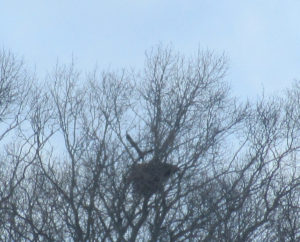
An adult bald eagle at the Upper Millstone River nest.
USGS GAUGES: My family through my maternal side has lived along Manalapan Brook in Helmetta or Monroe, Middlesex County, since 1900 or so. I was born, grew up, and am back living within 400 or so feet of the brook. So, I often use the brook’s United States Geological Survey stream flow gauge at Spotswood, Middlesex County, about 2 miles to the north as the crow flies, for research. For example, when the brook is running at about 50 cubic feet per second in Spotswood, I can no longer wade across the brook at my house — the velocity is too strong and maybe the brook is too high. And when the brook is running about 200 CFS in Spotswood, it is about to flow over its bank at my house. My added affinity to the Spotswood gauge is that it began operating in 1957, January, or two months after I was born — giving me almost a perfect record of brook flows of my lifetime. This week, I stumbled upon the USGS gauge on the Delaware and Raritan Canal at Kingston on the boundary of Middlesex, Mercer, and Somerset counties. See https://waterdata.usgs.gov/nj/nwis/uv/?site_no=01460500&PARAmeter_cd=00065,00060,62614 for the Kingston gauge. See https://waterdata.usgs.gov/nj/nwis/current/?type=flow for the stream flow gauges in New Jersey. There are more than 50 gauges in the Jersey Midlands.
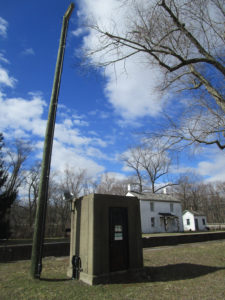
The United States Geological Survey stream flow gauge at Kingston on the boundary of Middlesex, Mercer, and Somerset counties.

Signs on the USGS stream flow gauge at Kingston.
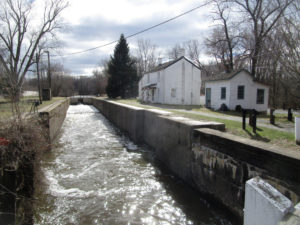
A lock of the Delaware and Raritan Canal at Kingston. The USGS gauge sits in the background, along the canal’s left bank.
CATCHING THE RIGHT LIGHT: On two days this week, I happened to catch views of soft sunlight on trees at dusk. And both times I captured it with my camera.
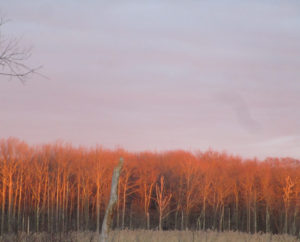
This shot is across the street from my house in Monroe, Middlesex County.
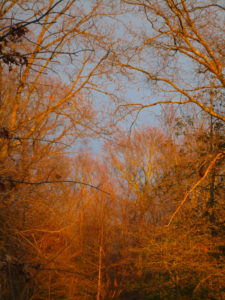
Another shot from across the street from my house.
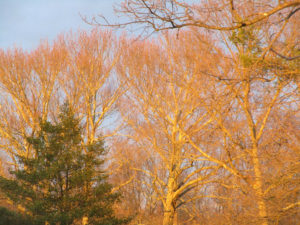
Another bit of golden sunlight at Monmouth Junction, Middlesex County.
SKY VIEWS: This week’s sky views were captured in East Brunswick, Helmetta, Monmouth Junction, and Monroe, Middlesex County, along with the Kingston area on the boundary of Middlesex, Mercer, and Somerset counties.

This photograph was taken at Thompson Park in Monroe, Middlesex County.

Helmetta Pond in the Pine Barrens around Helmetta, Middlesex County.

Carnegie Lake, formed by the damming of the Millstone River — this portion of the lake is on the boundary of Princeton, Mercer County; Plainsboro and South Brunswick, Middlesex County; and Franklin, Somerset County.

From my backyard in Monroe, Middlesex County, I captured this photograph of Canada geese, “Branta canadensis,” flying by.
CHRONICLING GARDEN AND AFIELD: Based on some things I have heard in recent days or months, I think people assume I spend a lot of time outdoors, finding what I write about. Actually, I do not spend enough time outdoors, either roaming the woods or in the yard! Whether I work 60 hours a week or am not working, I tend to chronicle the same way. That is, I do not pass up opportunities when I see them. I constantly have the camera with me and always have pen, pencil, and notebook with me. For example, this week’s report includes results of me having brunch in Hightstown, Mercer County; going to a doctor’s appointment in Plainsboro, Middlesex County; and dealing with the nor’easter in my neighborhood in Monroe, Middlesex County. My point, do not miss out on the outdoors world around us. It is there! Stay aware.
DRIVE-BY NATURALIST, STARLINGS: As I was driving through Monmouth Junction, Middlesex County, I came across a murmuration of starlings, “Sturnus vulgaris,” landing in trees. They are well-known for their flocks, or “murmurations.” “For much of the year, they wheel through the sky and mob lawns in big, noisy flocks,” according to Cornell University’s All About Birds website.
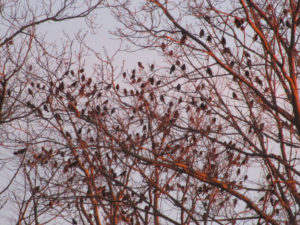
A starling murmuration in Monmouth Junction, Middlesex County.
STARLINGS, NO. 2: From reading “Garden and Afield,” you may have correctly deduced I hate non-native species, especially highly invasive ones. Not only do I find starlings, ” Sturnus vulgaris,” oily- and ugly-looking, they are non-native invasives. According to Cornell University’s All About Birds website, “All the European Starlings in North America descended from 100 birds set loose in New York’s Central Park in the early 1890s. The birds were intentionally released by a group who wanted America to have all the birds that (William) Shakespeare ever mentioned (in his writing). It took several tries, but eventually the population took off. Today, more than 200 million European Starlings range from Alaska to Mexico, and many people consider them pests.” The first thing we do, let us kill the starlings!
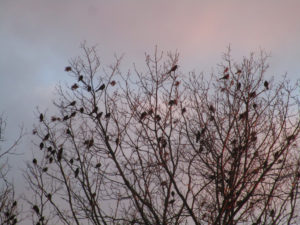
The Monmouth Junction starlings.
DAYLIGHT SAVINGS TIME: Daylight Savings Time begins Sunday, March 11, at 2 a.m. Spring forward with spring, so set the clocks one hour forward.
SUNRISE/SUNSET: DAYLIGHT SAVINGS TIME BEGAN SUNDAY, MARCH 11, AT 2 A.M.; SET THE CLOCKS ONE HOUR FORWARD. From Sunday, March 11, to Saturday, March 17, St. Patrick’s Day, the sun will rise about 7:15 to 7:05 a.m. and set about 7:00 to 7:05 p.m. From Sunday, March 18, to Saturday, March 24, the sun will rise about 7:05 to 6:55 a.m. and set about 7:10 to 7:15 p.m.
FULL MOON: The next full moon is March 31.
The March 4 moon, as seen through my living room window, waning from the March 1 full moon.
WEATHER: The National Weather Service forecasting office serving the Jersey Midlands is at http://www.weather.gov/phi/.
SPRING WILDFIRE SEASON: The Pine Barrens spring wildfire season generall runs from March 15 to May 15, when winds blow, humidity decreases, temperatures rise, and sun penetrates the essentially leafless forest, warming and drying the duff.
UPCOMING:
March 11, Sunday, 11 a.m. to 4 p.m., Atlantic County: 13th Annual Lines on the Pines, a Pine Barrens day of the written word, spoken word, art, and the performing arts at Stockton University, 101 Vera King Farris Drive, Galloway, 08205. More information at http://www.linesonthepines.org/linesonthepines.html.
April 9 to 15, Monday to Sunday, Mercer County: The annual Princeton Environmental Film Festival. Stand by for the specific schedule. This is a great event — not only showing environmental films, but some that are rather obscure. I try to go every year.
ME BAD OR ME GOOD? I blew off the Saturday, March 10, 29th Annual Pinelands Short Course to finish this week’s “Garden and Afield.” So, I wasted $50 and lost some knowledge. But as musician-singer-songwriter-friend Frank Pinto has noted, It is better to perform than to watch someone else perform. I am torn. In my early journalism days, I thought it was more important to write than read. Now, in my 40th year of journalism and my often tired state, I wonder….
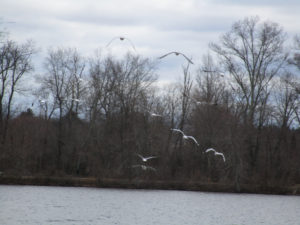
Gulls at Lake Carnegie on the boundary of Mercer, Middlesex, and Somerset counties.
Joe Sapia, 61, is a lifelong resident of Monroe — in South Middlesex County, where his maternal family settled more than 100 years ago. He is a Pine Barrens naturalist and an organic gardener of vegetables and fruit, along with zinnias and roses. He loves the Delaware River north of Trenton and Piedmont, too.
He draws inspiration on the Pine Barrens around Helmetta from his mother, Sophie Onda Sapia, who lived her whole life in these Pines, and his Polish-immigrant grandmother, Annie Poznanski Onda.
He gardens the same backyard plot as did his Grandma Annie and Italian-American father, Joe Sr. Both are inspirations for his food gardening. Ma inspires his rose gardening.
Joe is a semi-retired print journalist of almost 40 years. His work also is at @JosephSapia on Twitter.com, along with Facebook.com on the Jersey Midlands page.
Copyright 2018 by Joseph Sapia
























































































































































